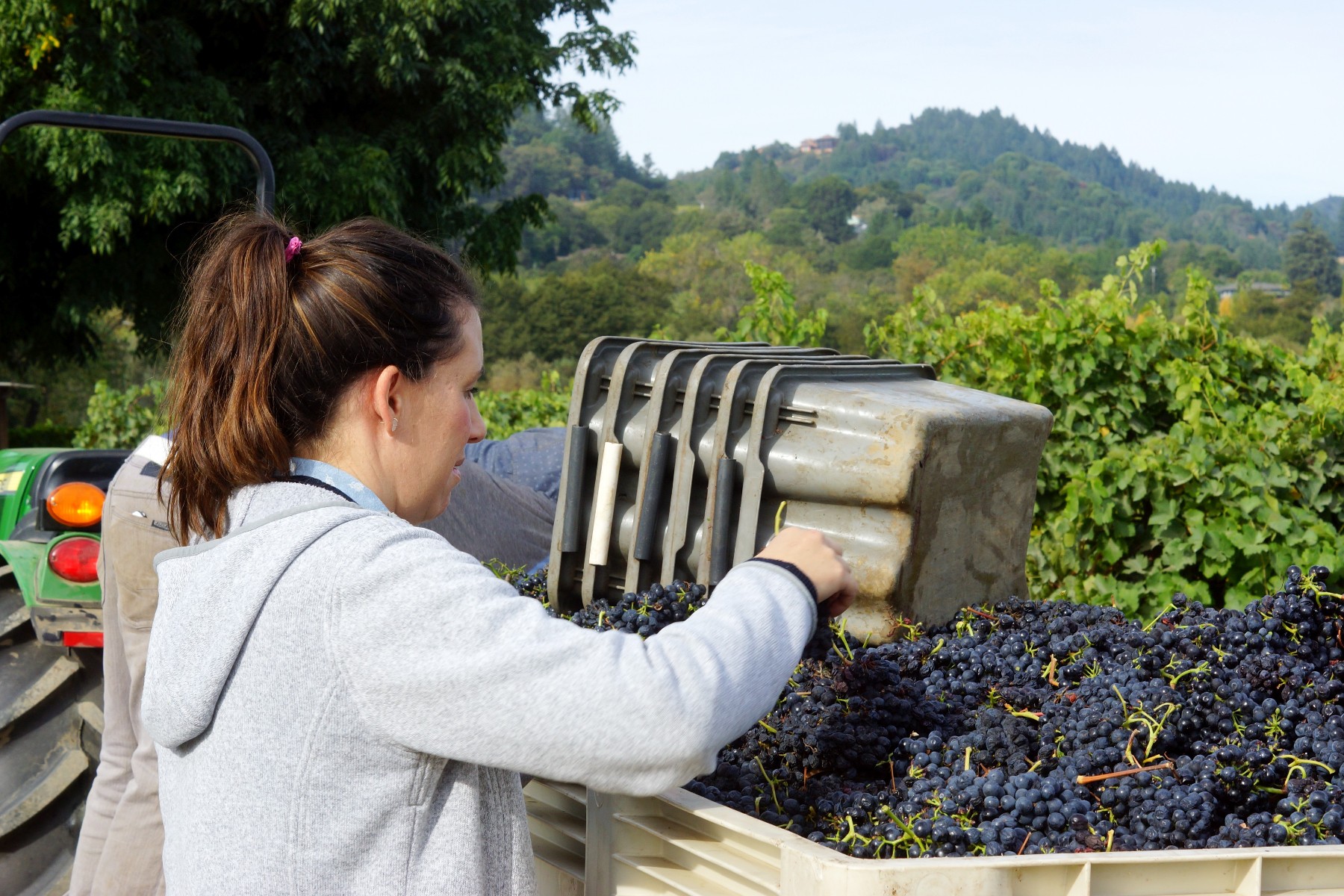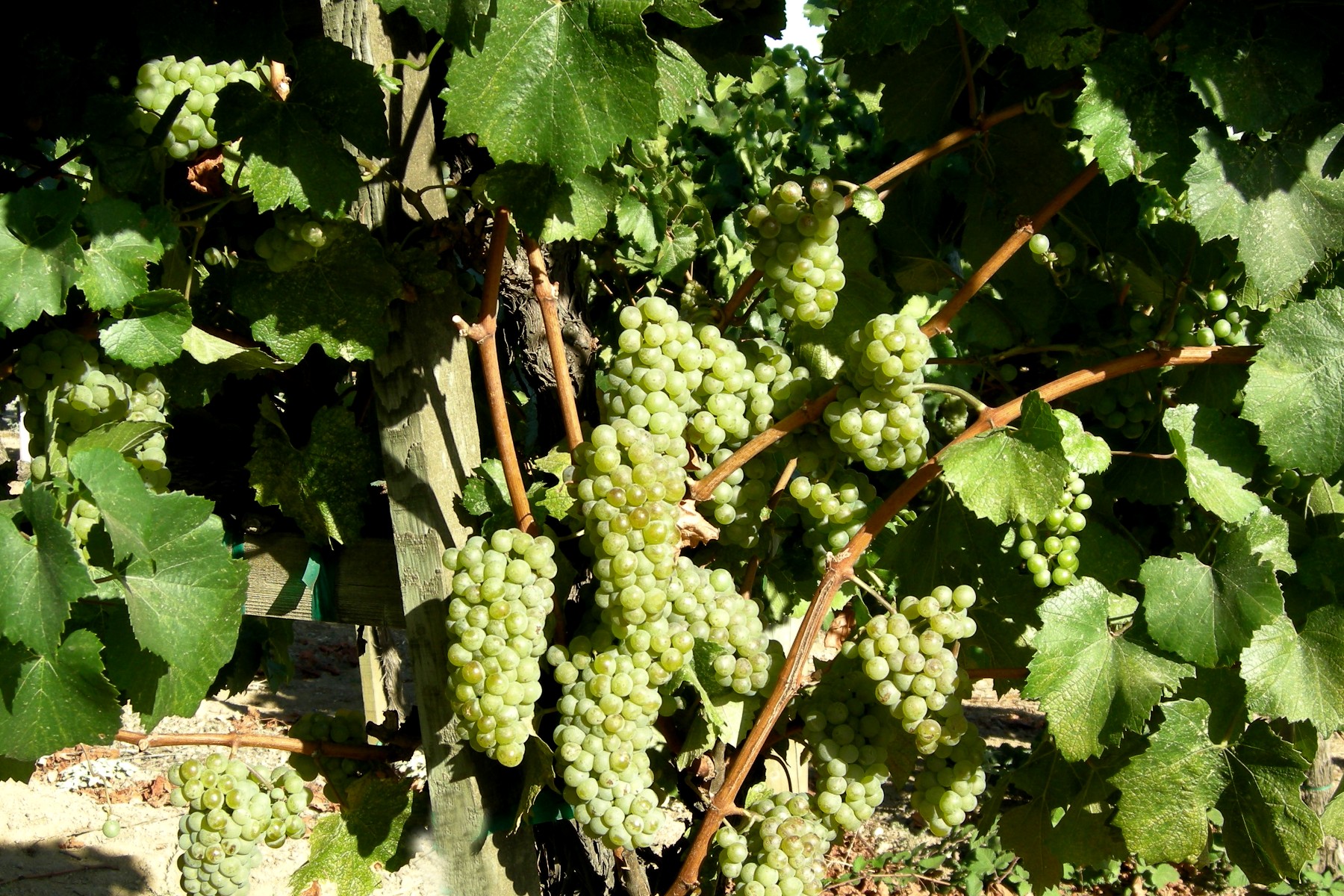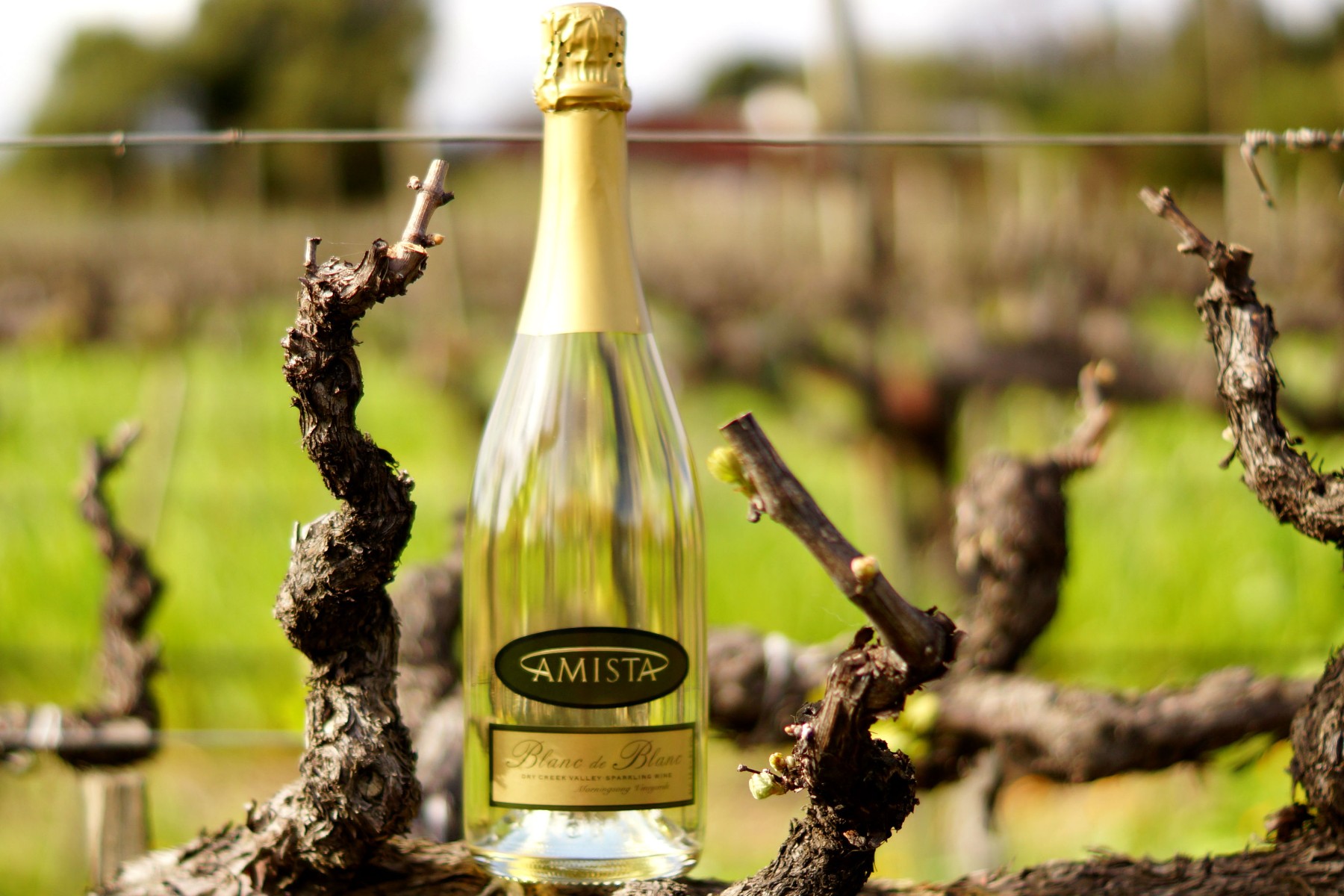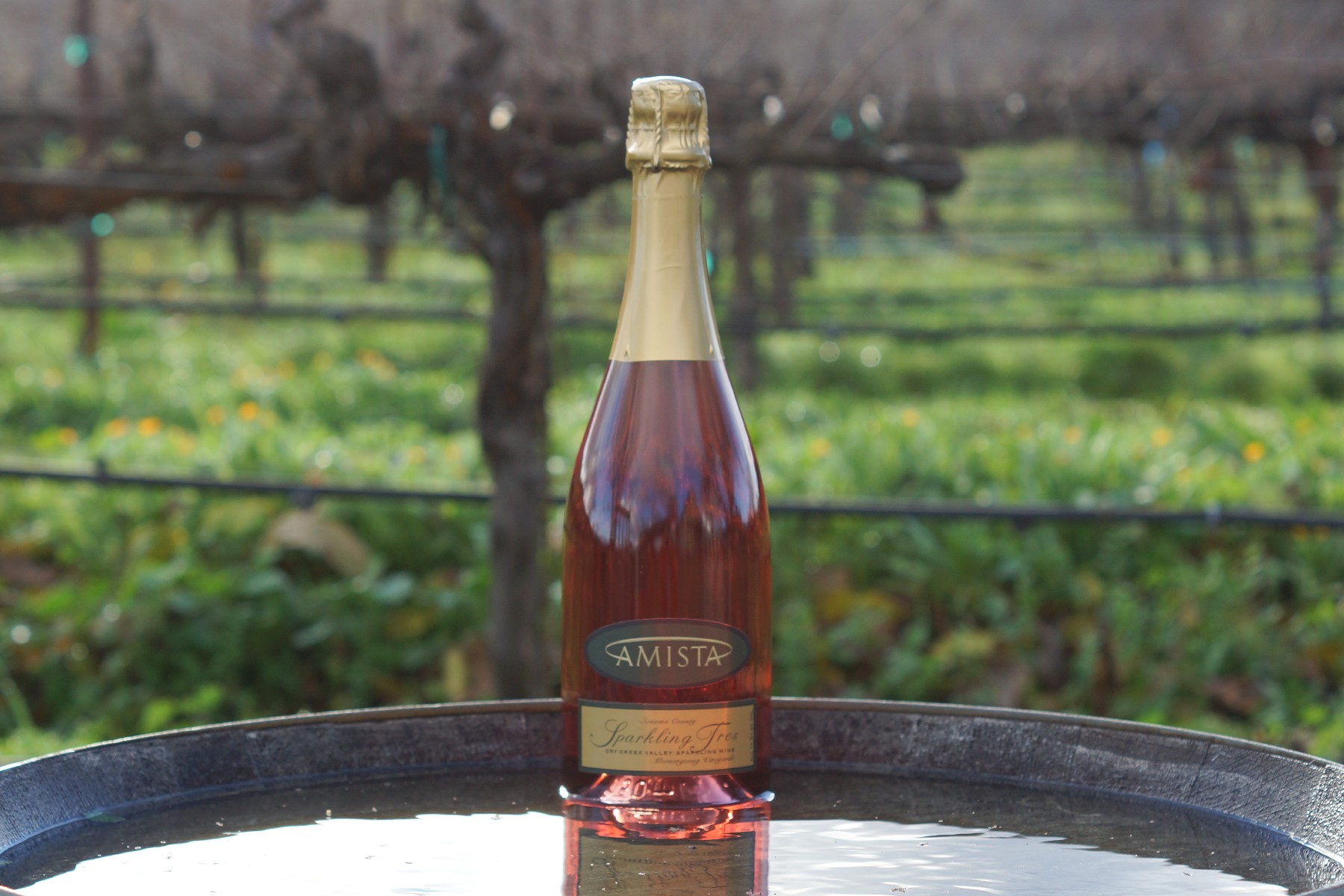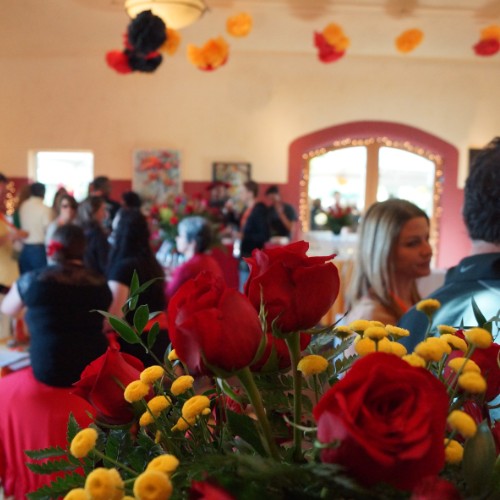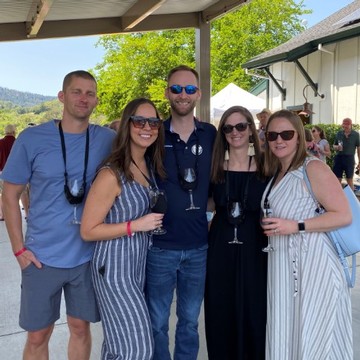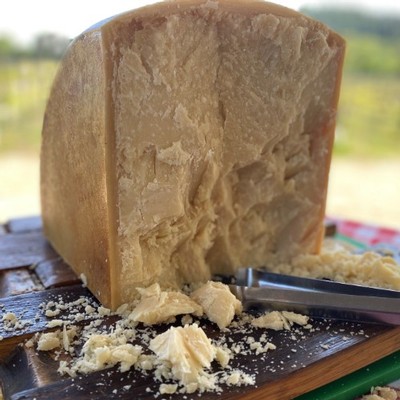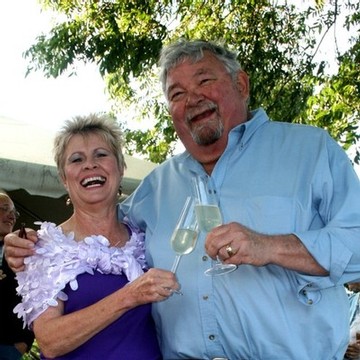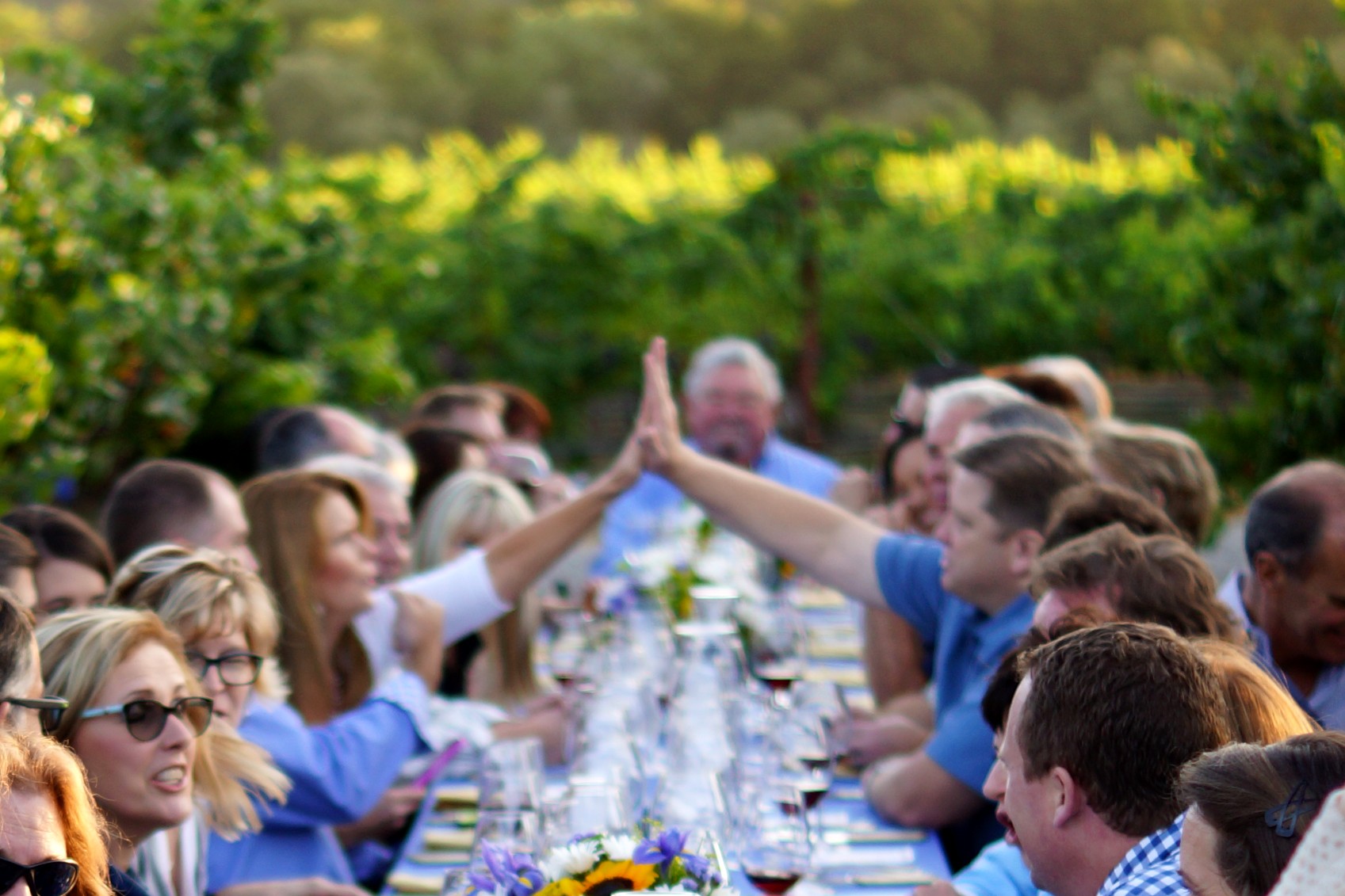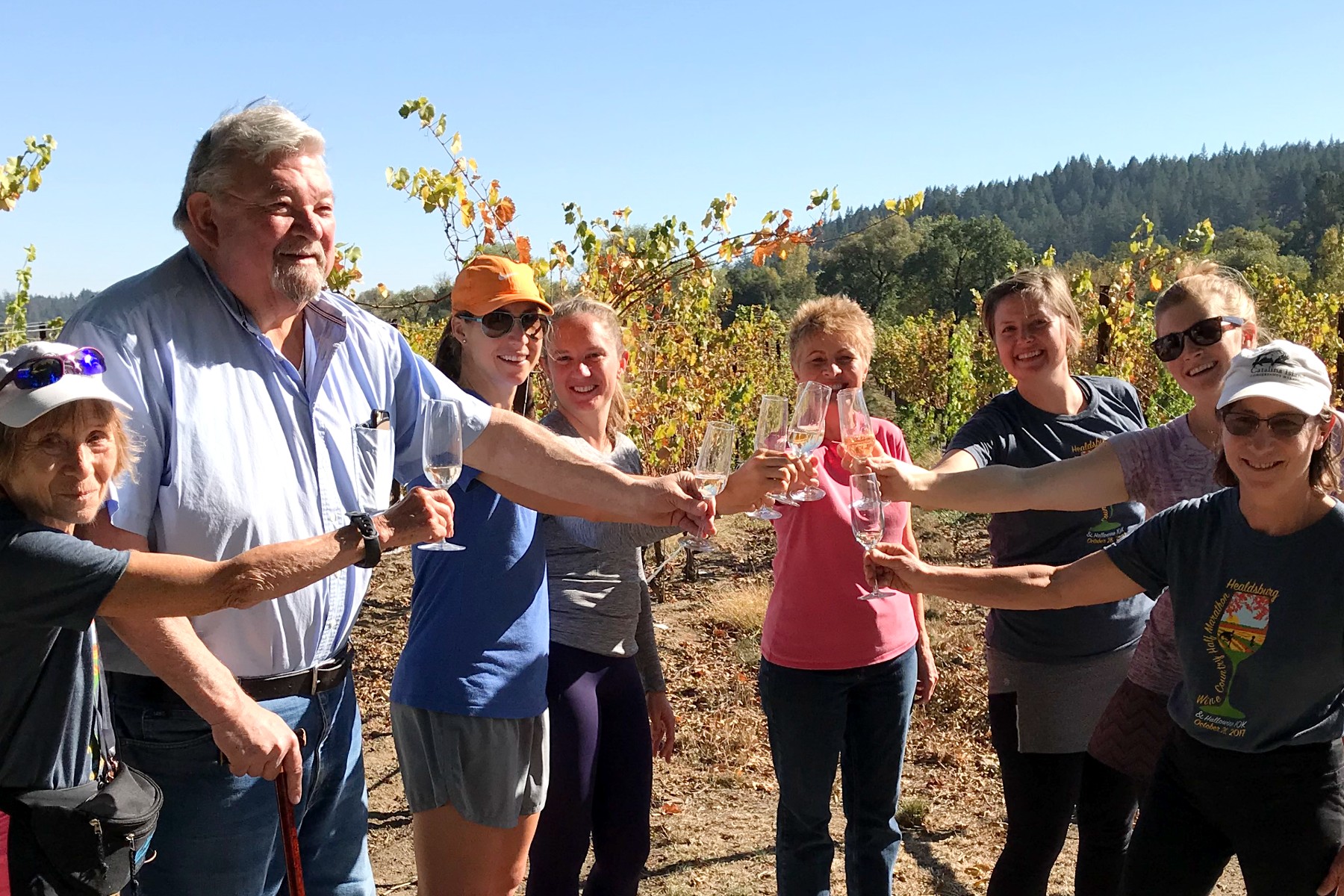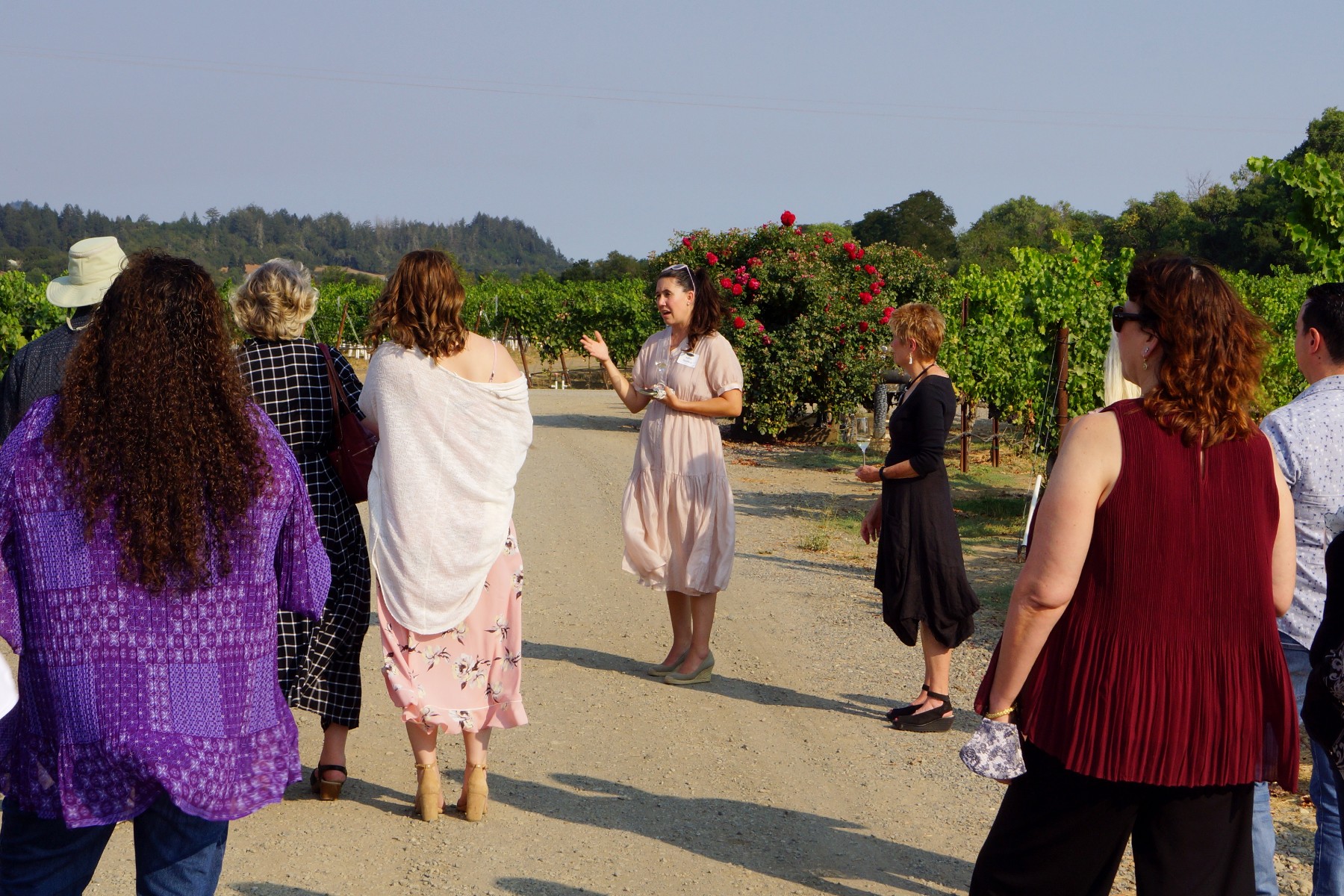News from Amista Vineyards
Winemaker Ashley Herzberg Discovers Sparkling Wine
I Fell in Love with Sparkling Wine & Now I Make It!
This year marks winemaker Ashley Herzberg’s 12th harvest at Amista Vineyards. She has been a sparkling wine trailblazer! She was the first to make a “grower sparkling wine” in Dry Creek Valley.
At the time, most sparkling wines in California were made by large producers with grapes purchased from multiple vineyards in the tradition of Champagne. In France, grower Champagne has become the rage in the last two decades with small, family-owned houses making Champagne from their own grapes.
Grower Champagnes are treasured because they are limited and hard to find. People love to discover hidden gems! And that’s what Ashley is making right here in Sonoma County.
We had a conversation recently about her sparkling discoveries.
How I First Discovered Sparkling Wine
Vicky
I know you love Champagne and sparkling wines. I’m curious to know what first drew you to sparkling.
Ashley
I actually really didn't like sparkling wine at first. My parents are the ones who introduced me to wine, and they didn't drink a lot of sparkling wine. My only exposure was to really bad sparkling!
I didn't know what was possible in the world of sparkling. I don't know what the exact catalyst or the exact wine was, but I think it was a Champagne and I realized how complex it could be. It can be toasty and yeasty, fruit driven and acidic. It can be so many things all in one glass and I just loved it.
Vicky
So, the first time you finally had a good sparkling wine, you fell in love?
Ashley
The very first time! Before that I thought very sweet sparkling wines were the only things that were available. Even when I was a child, I did not have a sweet tooth. I had an aversion to sugar. The only thing I knew was sparkling wine is sweet. And it's gross. It's not good wine.
“The only thing I knew was sparkling wine is sweet. And it's gross. It's not good wine.”
And then discovering that there was this whole other world, was so exciting. I realized there’s so much to learn about sparkling wine and so many wines to try. And there are so many different varietals you can use to make it.
Making My First Grower Sparkling Wine
Vicky
Clearly you developed a fascination with trying sparkling wines but when you joined us in as our winemaker in 2011, you had not yet made a sparkling wine. Did you even know we made a sparkling wine?
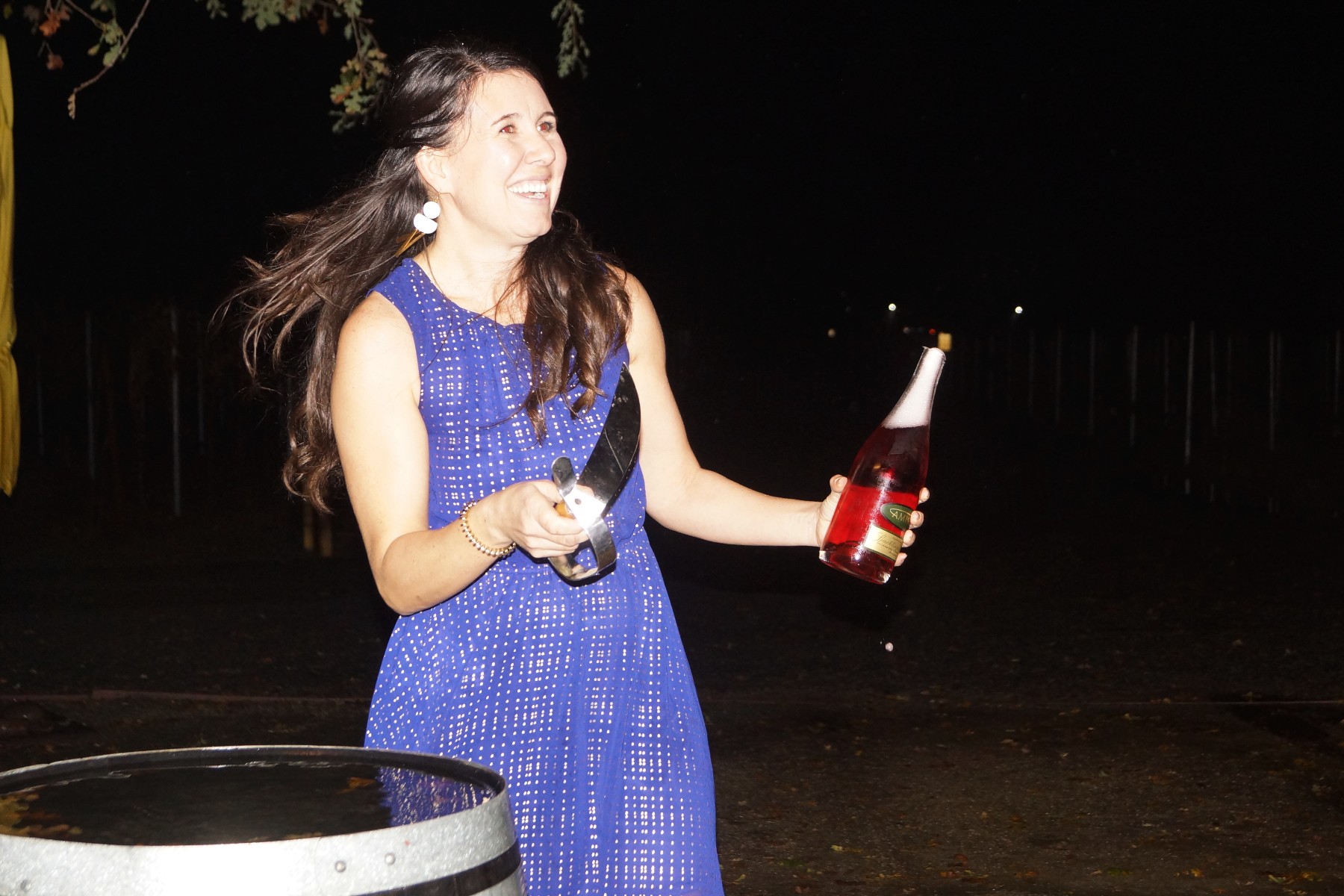 Ashley Herzberg Performing a Sabrage on a Bottle of Sparkling Wine
Ashley Herzberg Performing a Sabrage on a Bottle of Sparkling Wine
Ashley
Yes, because Mike (co-founder of Amista) had given me a couple bottles of your Sparkling Syrah as a Christmas gift. I assumed it was going to be sweet. I said to myself, “I’m not drinking that.” Many months later I pulled it out for my girlfriends, and they loved it. I had my first taste and was so excited.
Then two years passed between me tasting your sparkling before I came to you and said I wanted to work with you as your winemaker. In that time, I had already begun my exploration of sparkling wines and realized how much I loved them.
“The challenge and excitement of making a sparkling wine was enticing.”
I wanted to work with you because I had familiarity with your still wines. But the challenge and excitement of making a sparkling wine was enticing.
Lessons I Learned About Making Sparkling Wine
Vicky
Aside from being a lover of sparkling, I know you are also a lover of learning. What would you say are your biggest lessons learned about making sparkling wine?
Ashley
When I made that first sparkling wine, I knew how to pick for still wines, but I was so worried about when to pick for sparkling wines. How do you maintain the acidity and not have too high a sugar level? Penny (Gadd-Coster, consulting winemaker) at Rack and Riddle said, “you just still pick for flavors. You're shifting what you're looking for in those flavors. But you're still picking for flavors.” And I was like, oh, OK, I know how to do that!
Vicky
OK, so learning how to pick the grapes for sparkling wine was a big lesson learned. What else?
Ashley
Since I was starting from scratch on making sparkling wine, I didn't have any base of knowledge, so everything was something new to be learned. Penny was very important, especially that first year.
She was a ball of wisdom. Little things would come up in conversation. Penny had this very chill attitude about it, the way I had come to feel about making still wines. What I learned is that it’s just winemaking.
People say, ‘I’ve never made sparkling, and I wouldn’t know where to start. It’s so different than making still wine.” But it’s not. If you know how to make wine, you can make sparkling wine. Yes, there are some different processes for sparkling, but it is basically just the same as making still wines. That was really helpful to learn - you're just making wine.
Chardonnay Four Ways from Amista Vineyards
Including the First Sparkling Blanc de Blanc from Dry Creek Valley!
…and we didn’t think we liked Chardonnay!

We have always grown Chardonnay grapes on our estate Morningsong Vineyards, and we have come to love creating new wines from it. Today we offer four ways to enjoy Chardonnay and another coming in 2024 for our 20th anniversary.
Amista Vineyards Chardonnay Collection
Amista Chardonnay
- 100% chardonnay
- Harvested every year since 2004
Amista Sparkling Blanc de Blanc
- 100% Chardonnay
- Methode Champenoise
- Harvested every year since 2011
Amista Sparkling Fusión
- A blend of 80% Chardonnay and 20% red Rhône grapes - Syrah, Grenache or Mourvèdre
- Methode Champenoise
- Harvested every year since 2013
Amista Cristalina Chardonnay
- 100% chardonnay
- Fermented in a concrete egg imported from France
- From the Chardonnay Clone 4 block
- Harvested first in 2021
A New Sparkling Chardonnay Coming Soon!
On August 17, 2022, winemaker Ashley harvested Chardonnay from the "Lemonade Block" to make a special sparkling wine – yet to be named. We will release it in 2024 to celebrate Amista’s 20th anniversary.
Chardonnay in Dry Creek Valley
We found our Dry Creek Vineyard in 1999 – on the internet! We were living in New Jersey at the time and my husband Mike was yearning to return to California where he had made his first wine in our garage. We have always loved the town of Healdsburg and the Dry Creek Valley, which we first discovered when we visited from our home state of Colorado back in 1983. So, finding a vineyard here was a dream come true.
Our love affair with Sonoma County and Healdsburg continued after we moved from Colorado to Silicon Valley. Perhaps our frequent visits were what inspired Mike to plant a backyard vineyard on a hillside at our home in Saratoga, California, and then to try his hand at making wine in our garage. Back then, making wine and growing grapes were brand new hobbies for Mike.
But the hobbies were cut short when I got a job offer in New Jersey. We never saw our vineyard produce grapes because the vines were only a year old when we left. Fortunately, the wine Mike made in the garage was in a barrel that we took with us to New Jersey and aged in our basement. After a few years, the Cabernet Sauvignon was ready to drink. We shared it with friends who declared it to be delicious and Mike’s secret dream of becoming a winemaker was fortified.
That is what prompted him to start looking for properties near Healdsburg and led us to this beautiful 28-acre vineyard located in the heart of Dry Creek Valley. At that time, the entire vineyard was planted in Chardonnay. Over the years, we have replanted every vine and replaced some of the Chardonnay with Rhône varieties.
Why Chardonnay?
Ironically, we didn’t even make Chardonnay during our inaugural year in 2003 because it wasn’t one of our favorites, even though over half the vineyard was planted in Chardonnay at that time. We were persuaded to make our first Chardonnay in 2004 by two of our club members and we have made it ever since. We decided to make an unoaked Chardonnay (fermented in neutral oak barrels) which was unusual for California Chardonnays of that era. We much preferred it to the big oaky Chardonnays and we’ve continued to make it in that style throughout the years.
Chardonnay – Making it Sparkle!
We made our first sparkling wine in 2008 from our estate Syrah grapes and it quickly became a cult favorite. When our winemaker, Ashley Herzberg, joined us in 2011, the two of us immediately conspired to make a Blanc de Blanc from our Chardonnay because we both adore sparkling wines.
I am especially delighted that we started making it because Blanc de Blanc has become my “go-to” wine! A glass of “Blanc” marks the end of my workday and a time to throw frisbees for the dogs as we sit on the deck and enjoy looking out over our Chardonnay vines. Often, we enjoy the Blanc de Blanc with our entire meal.
Fusión - Our First Sparkling Blend
It didn’t take long for Ashley to add more sparkling wines to our collection. Every wine we made during our early years was from a single variety (except Ilusión, a port-style dessert wine, but that’s a story for another time). Although making single varietal wines requires skill and has its own set of challenges due to the vagaries of weather and water with each vintage, winemakers love to do blends.
So, it was no surprise that Ashley wanted to make a sparkling blend and created a wine we call Fusión, made from Chardonnay with a kiss of Grenache and a bit of either Syrah or Mourvèdre.
Cristalina from a Concrete Egg
I have also fallen in love with Cristalina, our newest Chardonnay, fermented in a concrete “egg”. The idea of making a second Chardonnay emerged in a conversation about how we could use more of our estate fruit in our Amista wines. Winemaker Ashley threw out the idea of fermenting a Chardonnay in concrete, which sounded intriguing.
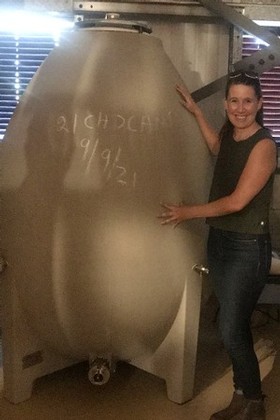 She went off to research concrete fermentation vessels and came back with a proposal to acquire a concrete egg. She knew exactly the one she wanted, called an “Oeuf de Beaune”, a concrete fermenter in the shape of an egg imported from France.
She went off to research concrete fermentation vessels and came back with a proposal to acquire a concrete egg. She knew exactly the one she wanted, called an “Oeuf de Beaune”, a concrete fermenter in the shape of an egg imported from France.
Ashley describes how the egg shape creates a natural circulating effect while the grape juice is fermenting on the yeast and exposes the wine both to air at the top of the vessel and to the concrete, which heightens the sense of minerality that is naturally present in the wine from our rocky vineyard soil.
Want to learn more about "the egg" and its affect on the wine? Check out the "Concrete Egg" video from Ashley.
Come Taste With Us and discover Chardonnay Four Ways from grapes harvested in our Morningsong estate vineyards, or treat yourself to our Rhône reds and sparkling wines.
What is Blanc de Blancs?
A Sparkling White Wine Made from White Grapes
…typically, Chardonnay

First, I must confess that our Amista Blanc de Blanc is the bubbly I drink most often. It marks the end of my workday and the beginning of the evening. I pour a glass and either head for the back deck where my husband Mike and I throw the frisbee for our dogs and gaze out over the Chardonnay vines, or as we prepare dinner. He does the entrée. I do the salad.
White from Whites
But I digress. Blanc de Blancs, translated from French, means literally “white from whites”. The term originated in the Champagne region of France where the wine is nearly always made from 100% Chardonnay grapes. This contrasts with most Champagne that is a blend of three grapes, Chardonnay, Pinot Noir and Pinot Meunier.
How Does a Blanc de Blancs Taste?
Typically, a Blanc de Blancs from Champagne will be crisp and clean with a lively acidity and a touch of minerality, and in some cases a yeasty component developed during fermentation. However, the taste varies widely depending on the specific location the grapes were grown, the winemaker's style, the dosage (small amount of sugar added to the finished wine), and the amount of time the wine spends on the lees (the yeast). Wines that spend more time on the lees will have more of the yeasty character.
Is Blanc de Blancs made only in Champagne?
Today, sparkling wines are made around the world in all countries where wine is made and that goes for Blanc de Blancs. You can find lovely examples from elsewhere in France, Spain, Italy, Germany, England, South Africa and of course, here in the U.S. I suppose technically, Blanc de Blancs could be made from any white grape, but they are almost always made from Chardonnay following the French tradition.
Is Blanc de Blanc Sweet?
It’s usually dry. Fine Blanc de Blancs from Champagne and elsewhere in the world are typically on the dryer side, designated as Brut, Extra Brut or Brut Nature. The sweetness is determined by the amount of dosage (a mixture of wine and sugar) that is added to the sparkling wine just before the cork and cage are put on the bottle.
There are several levels of sweetness designated for Champagne and sparkling wines as measured by the number of grams per liter of sugar added.
Doux - more than 50 grams of sugar per liter
Demi-sec - 32-50 grams of sugar per liter
Sec - 17-32 grams of sugar per liter
Extra dry - 12-17 grams of sugar per liter
Brut - less than 12 grams of sugar per liter
Extra brut - 0-6 grams of sugar per liter
Brut nature – 0 – 3 grams of sugar per liter
Our Amista sparkling wines are typically Extra brut or Brut Nature. We have found that most of our customers (and I) like our sparkling wines dry.
What Foods Pair with Blanc de Blancs?
In my book, almost everything! There are some classic pairings that are always wonderful like briny oysters on the half shell, crab cakes, grilled sea bass, and sole picatta. It is also lovely with hard cheeses – I especially love aged Parmesan – or as a counterpoint to soft triple cream cheeses.
It goes equally well with comfort foods, especially fried foods like fried chicken, French fries and Fritto Misto. It's perfect with grilled chicken, garden salads and light pasta dishes like linguine with pesto or fettucine alfredo.
I recently heard of another comfort food pairing from a friend that I can't wait to try. He had it with creamy potato soup and crusty homemade bread. He said “This totally worked with a glass of Blanc de Blancs. The Blanc was refreshing and balanced the richness of the soup."
For something more casual, pour a glass and take it to the pool with a bag of potato chips and some crème fraîche for dipping and you'll be happy. We like to serve it in our tasting room with freshly popped popcorn with a drizzle of olive oil and a dusting of lemon herb salt.
Karen MacNeil, author of the Wine Bible says, “Blanc de Blancs Champagne is the best wine ever for a hot summer night.” I agree with her, except I would not limit it to Blanc de Blancs made only in Champagne.
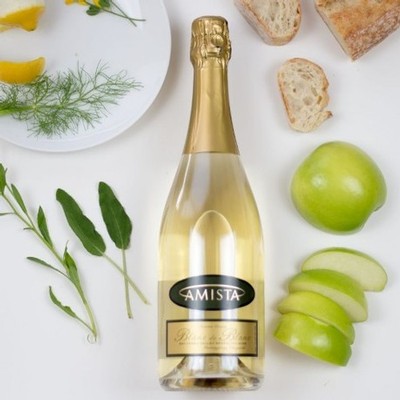 How Does Amista Blanc de Blanc Taste?
How Does Amista Blanc de Blanc Taste?
Our Amista Blanc de Blanc (you may notice we use the singular “Blanc” – don’t ask me why), is always crisp, refreshing and bright. Although we don’t vintage date it, we make it from a single vintage, so it varies a bit from year to year. It typically has lemony notes with green apple and sometimes the flavors of Asian pear.
If you want to discover for yourself, please Come Taste with Us. We have several sparkling wines made in the classic Méthode Champenoise, as well as a collection of estate grown Rhône wines.
Amista Uses Méthode Champenoise to Make Sparkling Wines
What is Méthode Champenoise?
What I’ve learned about it and what makes it special…
We made our first sparkling wine in 2008 and it’s been an amazing process of discovering how sparkling wine is made and how the process differs from making our reds, whites, and rosés. I always loved drinking sparkling wine, at least once I realized it could be dry and interesting and delicate. But I didn’t know how it got to be that way until we started making it ourselves. Today we make six estate grown sparkling wines!
What is Méthode Champenoise?
Méthode Champenoise or Méthode Traditionnelle is the process used to make French Champagne, as well as many other sparkling wines around the world. There are several methods for making sparkling wine and the method thought to produce the best sparkling wines is the traditional method.
In this method, the wine goes through a secondary fermentation in its own bottle. Unlike still wines that are fermented only once in tanks, barrels or other vessels, sparkling wines are fermented twice. The second fermentation is what makes the wine “sparkle”.
What is Secondary Fermentation in the Bottle?
After the initial fermentation, the sparkling wine is bottled with an additional mixture of sugar and yeast, called the liqueur de tirage. The sugar acts on the yeast producing carbon dioxide gas that is trapped in the bottle, thanks to a crown cap (like a bottle of beer). Quality sparkling wines are left on the yeast, or lees, for several months, sometimes years.
Does the Yeast Stay in the Bottle?
No, and this is another distinctive feature of the Méthode Champenoise. The reaction of the sugar and yeast produces carbon dioxide and dead yeast cells. The residual yeast cells are removed by a process called disgorgement.
What is Disgorgement?
I know, it isn’t exactly the most appealing word for such a beautiful wine. It sounds much better in the original French – dégorger. In disgorgement the dead yeast cells are propelled from the bottle when the crown cap is removed.
What is Riddling?
Prior to removal of the crown cap, the bottles are riddled, a process where the bottles are turned on their heads and slowly shifted each day until all the dead yeast cells are in the neck of the bottle. Then the neck is frozen creating an icy plug of the residual cells. When the crown cap is removed, the plug is forced from the bottle by the pressure of the carbon dioxide in the wine. It’s quite an ingenious process.
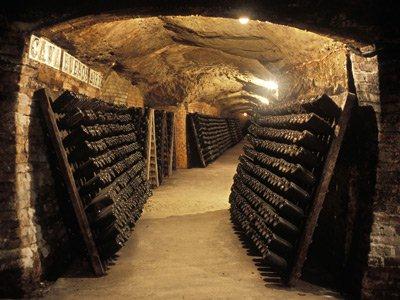
Riddling Racks in a Cave
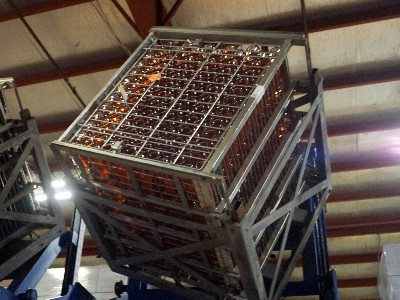
Gyropallete Riddling Amista Fusión
The process can be done by hand by experienced “riddlers” with the bottles resting with the tops down in riddling racks. It’s more common today to accomplish riddling in huge cages that gently shake the wines on a daily schedule. Disgorgement can also be done by hand but is much faster and safer to do by machine. It’s fascinating to watch - providing you have on a pair of safety glasses and are standing behind the safety glass!
Why is Méthode Champenoise Preferred?
Fermenting the wines in their own bottle is what produces the fine bubbles that are coveted in the best Champagnes and sparkling wines. There are other methods of producing sparkling wines that are faster and less expensive, but do not produce the delicate bubbles and more complex flavors of a fine sparkling wine.
Want to treat yourself to our bubbles? Come Taste with Us! In addition to our collection of estate grown sparkling wines we also have a wonderful lineup of Rhône reds.
Wine and Food Festival Tips - Make It Magical!
My Top Ten Tips
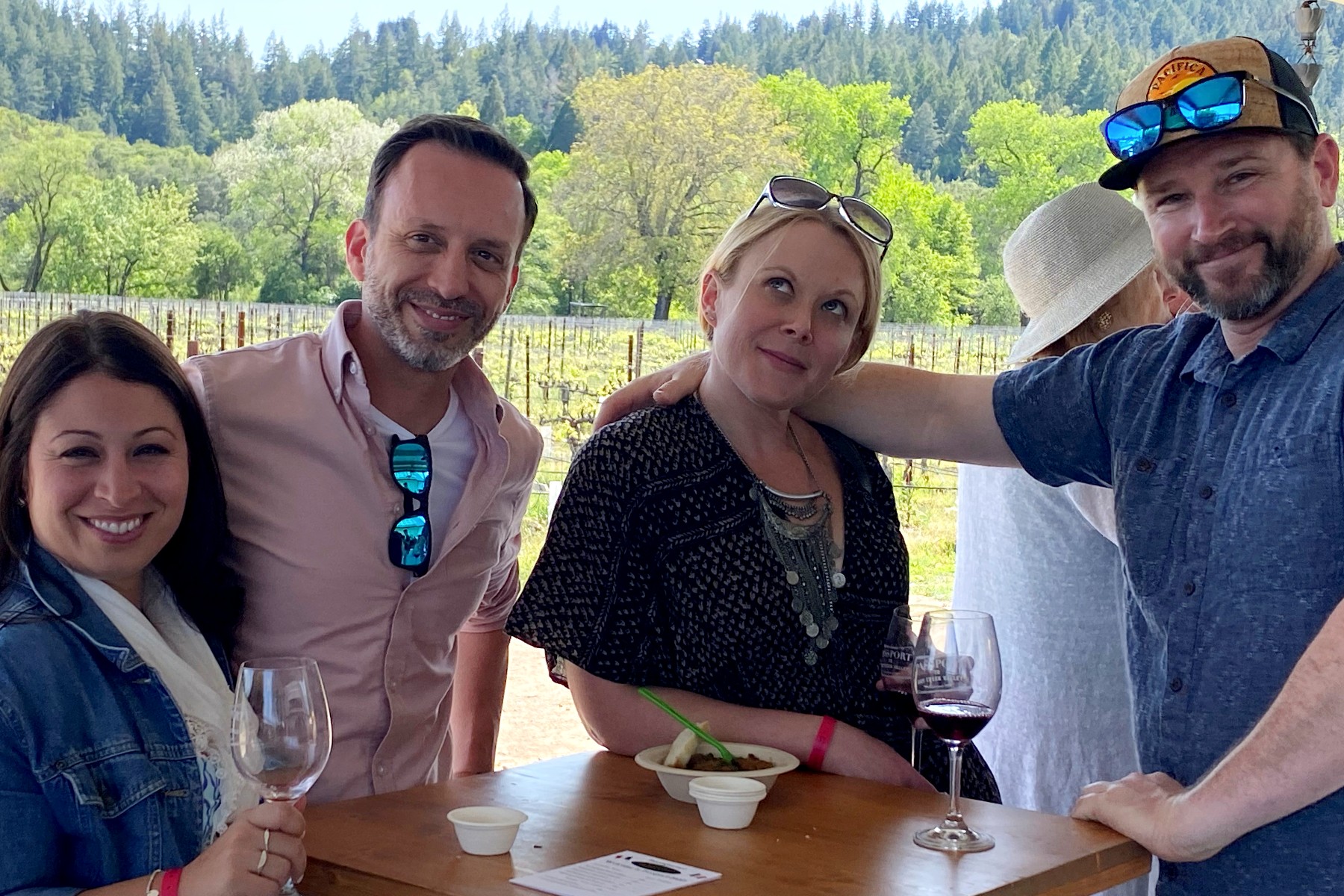
...based on 20 years of Passport to Dry Creek Valley, the premiere wine and food festival in Sonoma County
I know I’m hopelessly partial, but my favorite wine festival happens right here in Healdsburg, California – where we live. It’s called Passport to Dry Creek Valley® and even before we lived here and started our own winery, we loved Passport. Now we are hosts. I’ve learned a lot about wine events over the years being on both sides and asking the veterans who attend year after year.
Wine festivals can be magical weekends shared with a special person or a whole group of friends. Here are my tips for how to make them remarkable. But first…
What is a wine festival?
A wine festival is an event featuring wine tasting from many wineries all included for a single ticket. The event often showcases a wine growing region or varietal. I am partial to the ones that also include food. And I love the chance to meet the winemaker and owners.
There are two main formats. The first takes place all in one location. The second enables participants to travel from winery to winery.
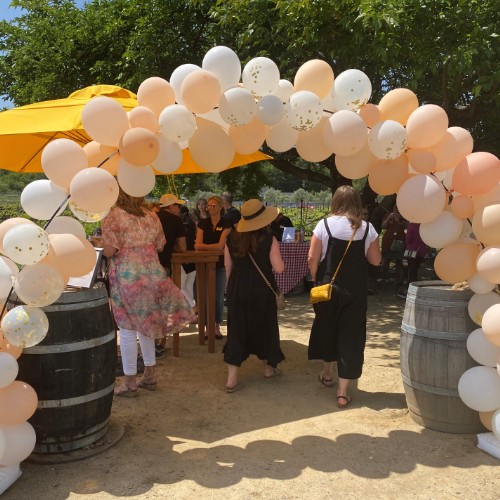
The focus of this post will be on events where participants visit the wineries. This is my clear choice since you can discover the personality of each winery by seeing it in its natural habitat – whether it be a warehouse, an urban storefront or surrounded by vineyards and breathtaking views.
So Why Go to a Wine Festival?
The logical reason is that it’s an opportunity to visit and taste the wines of many wineries with just one ticket. But for me, the real draw is that these events are elevated from the everyday and have a festive atmosphere, which makes the perfect inspiration for a memorable getaway weekend.
Most festivals also include something you won't find by visiting at other times, special wine and food pairings, entertainment, education, barrel tastings, opportunities to meet the winemakers and owners, or access to wineries not generally open for tasting.
Here are my Top 10 Tips
1. Choose the event that’s right for you.
Where and what time of year? You might want to explore a region you've never visited. Wine festivals are held in all parts of the world. On the other hand, we know people who have fallen in love with a particular wine region or event and return every year.
What matches your style and budget? Some events include inspired food pairings by acclaimed chefs along with entertainment. Others are laid back and offer small bites or encourage you to bring a picnic.
2. Leverage your wine club memberships.
3. Go with people you really enjoy.
Some people like to attend with one special person - a spouse, a partner, a best friend. We have one couple that comes from New Jersey every year. Others like to get a group of friends or family together and make it a special occasion weekend. A group of seven couples comes every year for their annual wine buying weekend. You're going to be spending a lot of time together, so be sure you're compatible traveling companions!
4. Book your lodging early.
Event weekends bring thousands of people into the area and lodging is booked well in advance. Our regular Passport guests usually book next year's lodging while they're in town for this year's event. The event organizers often provide a list of local lodgings or if you're a club member of a participating winery, they can generally recommend places to stay.
5. Take advantage of ancillary events.
6. Know what you like and plan accordingly.
7. Explore - go to some wineries you've never visited.
8. Ask for suggestions.
9. Pace yourselves.
Minimize driving time by optimizing your route. Either plan it out in advance or drop in to several wineries in the same area.
10. Book a driver.
2022 Passport to Dry Creek Valley
We were overjoyed to host Passport this year after a two-year hiatus. The guests seemed even more ecstatic to be back. The mood was festive and friendly. We featured two of our estate-grown Rhône inspired wines, a 2020 Grenache and 2018 Syrah. They were both big hits. A huge “hunk” of Parmesan, aged 24 months, made a great partner with the Grenache. And the Syrah was the perfect match for braised shortribs with polenta, from our wood fired oven.
For our club members and declared sparkling lovers, we offered entry to the “bubble lounge” where our guests could try the newest addition to our collection of sparkling gems, Sparkling Tres. It is made from three Rhône varieties, Grenache, Syrah and Mourvèdre.
Amista Vineyards
Vicky and Mike Farrow
If you come to any of the wine events in our area, we invite you to visit Amista just outside the charming town of Healdsburg, California. We’ll be standing out front welcoming you or meandering through the crowd.
Or come Taste with Us any time!
Secrets of the Amista Wine Tasting Barn
A Beautiful, Energy Efficient, Solar Powered, Wine Tasting Space with a Secret Welcome Sign
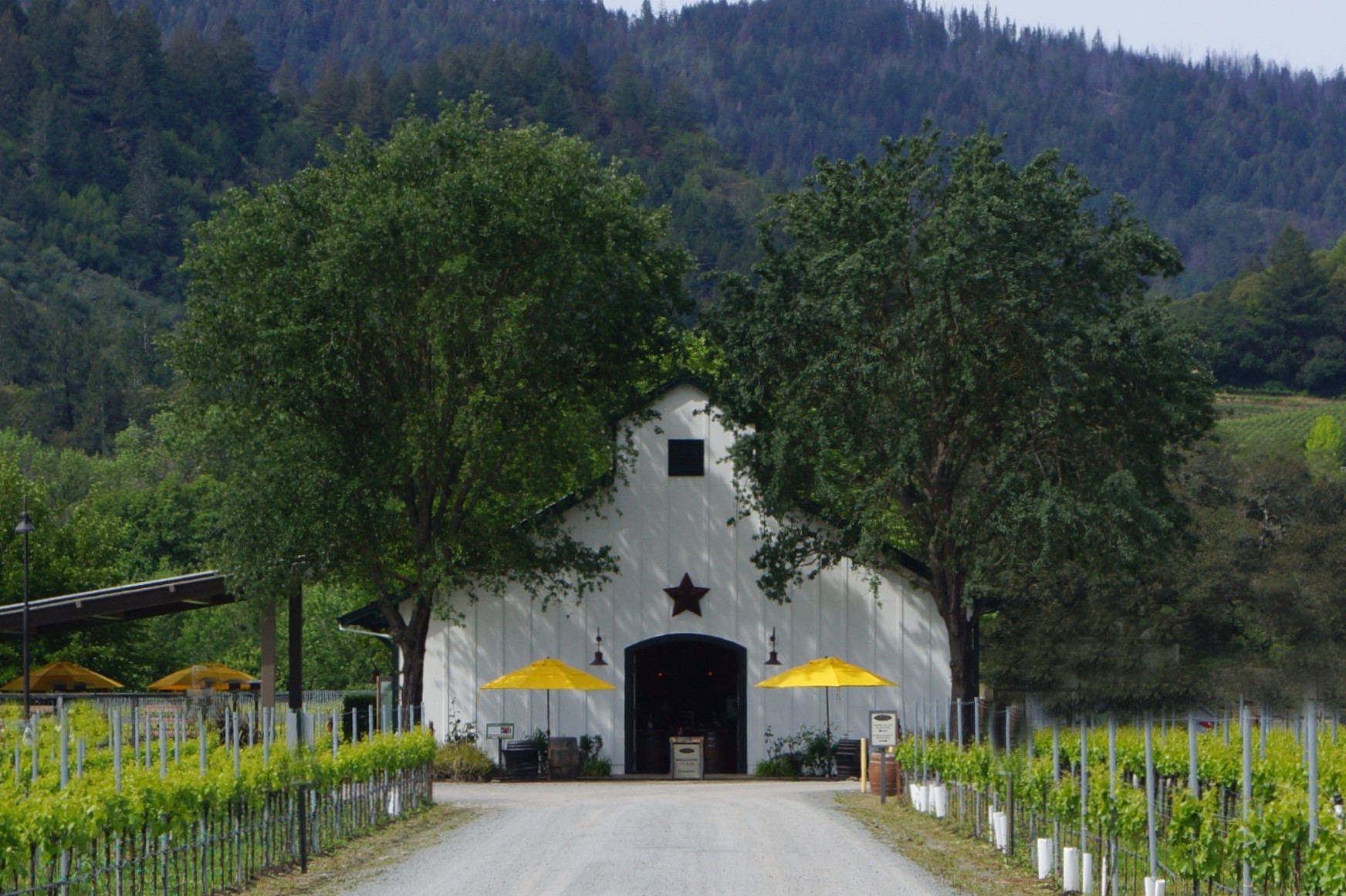
Five secrets revealed...
Painting it White
Paloma Blanca has arrived at Amista Vineyards! That’s the name of the new color we painted our barn, which means White Dove. Gone is the sage color that made the building melt into the many shades of green on the hillsides behind it. I secretly wanted to keep it that way. I liked the fact that it blended into its environment. Brian, our estate director, had another idea. His vision was to create a modern farmhouse look. He was right. It provides a stunning backdrop for the indigenous Valley Oaks that frame the barn and our hallmark yellow umbrellas. It looks fresh; it pops; it’s beautiful!
Creating a Place for Wine Tasting in Mike's Dream Winery
If our barn could talk, it would reveal a lot of secrets. Like the fact that it was originally designed to be a production facility. It has a concrete pad for crushing grapes. It has a big roll-up door on the “crush pad” side and huge double doors in the front that are sized for a forklift. It has a little back room that was supposed to be the lab, a drain running down the middle of the floor and a wine production-size septic system. It has lots of windows in the clerestory that were intended to bring natural sunlight into the production area. It was Mike’s dream winery.
About halfway through the construction, I told him I thought it had a higher purpose. Since our property is in the very heart of Dry Creek Valley and only three miles from the charming village of Healdsburg, I wanted the entire building to become a tasting room. I figured we already had a place to make our wine at a local custom crush facility, but we desperately needed a place to sell it. And we needed a place to welcome guests and host our wine club members.
Without a tasting room, we had come up with the idea of hosting tasting parties in the homes of friends all over the Bay Area. The parties were a big success. We had fun telling our story in a casual setting, met a lot of new people, sold a lot of wine, and signed up a lot of club members. On the other hand, driving for two hours, hosting a party, and then driving home at night made for a long day. Plus, we couldn’t even have a glass of wine with our new friends since we had to drive back home. It was not a long-term solution. And that’s the story of how Mike’s dream winery became a tasting room. He’s always been a little sad about it, mostly because he never got his forklift!
Building an Energy Efficient Building
Another secret the barn would reveal is that is constructed of ICF blocks and the walls are a foot thick. ICF’s or insulated concrete forms, are blocks with two layers of thermal insulation with space in between to fill with concrete. They are assembled as interlocking modular units that are dry stacked without mortar. The units lock together something like Lego blocks. Once the blocks reach a certain height, they are filled with concrete. The process is repeated until the full height of the building is achieved. The forms stay in place providing both insulation and strength.
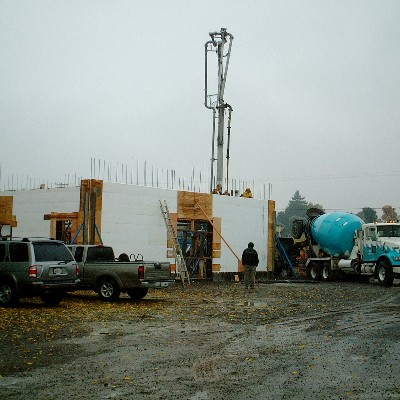 ICF’s are more energy-efficient than most construction materials resulting in energy savings and reduced environmental impact. The thick, steel-reinforced concrete walls also protect against fires and earthquakes. Because of the energy efficiency of the walls and the carefully designed system that blows warm air out from vents at the top of the clerestory and draws cool air into the vents near the floor at night, there is no need for air conditioning. Of course, you must keep all the doors closed on warm days for this to work properly – a concept that would have been perfect for a production facility but maybe not so great for a tasting room where everyone wants to see the view!
ICF’s are more energy-efficient than most construction materials resulting in energy savings and reduced environmental impact. The thick, steel-reinforced concrete walls also protect against fires and earthquakes. Because of the energy efficiency of the walls and the carefully designed system that blows warm air out from vents at the top of the clerestory and draws cool air into the vents near the floor at night, there is no need for air conditioning. Of course, you must keep all the doors closed on warm days for this to work properly – a concept that would have been perfect for a production facility but maybe not so great for a tasting room where everyone wants to see the view!
Adding Solar at Amista
And the view is truly worth seeing – lush vineyards in the foreground with a backdrop of tree-studded hillsides revealing multiple layers and shades of green. People gravitated to the outdoor space, so we put up a large white tent to protect them from the sun.
The tent provided shade for over ten years, but I’m sure that our energy efficient barn secretly yearned for a more suitable partner. In 2020 we finally built a patio with a shade structure entirely covered in solar panels. We also added panels on the south-facing roof of the barn. The new solar system powers the tasting room, our home and all the wells on the property.
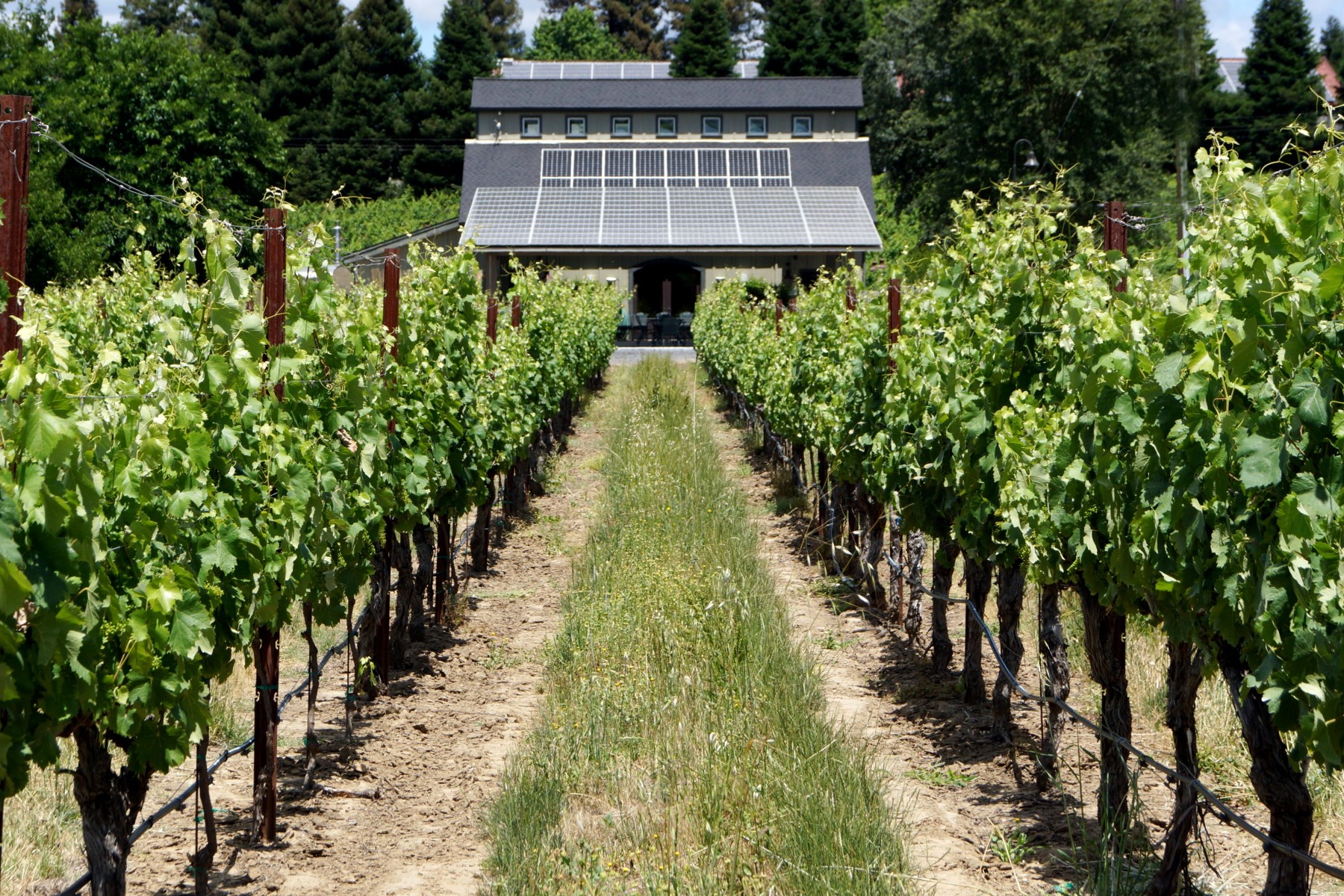
I wonder if the barn carries the secret of who came onto the property in the middle of the night and stole two tons of Mourvèdre grapes that were almost ready to harvest. But that is a story for another time!
Revealing the Secret Amista Welcome Sign on the Door
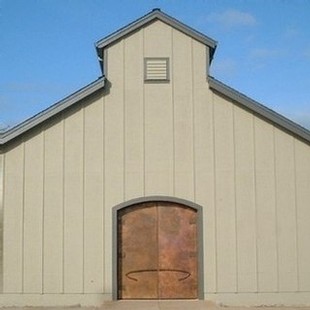 Our barn was completed in 2007, making it 15 years old. I wonder what other secrets it holds. It has certainly had its share of wonderful people coming through its massive copper (on the outside) and brass (on the inside) double front doors. The doors were a gift from my mother, designed and crafted by an artisan blacksmith in Berkely, California. The handles on the outside are in the shape of what I call the Amista “swoop”, that surrounds the word Amista on our logo. The swoop represents arms opening, the perfect sign of welcome to Amista, which means making friends in Spanish.
Our barn was completed in 2007, making it 15 years old. I wonder what other secrets it holds. It has certainly had its share of wonderful people coming through its massive copper (on the outside) and brass (on the inside) double front doors. The doors were a gift from my mother, designed and crafted by an artisan blacksmith in Berkely, California. The handles on the outside are in the shape of what I call the Amista “swoop”, that surrounds the word Amista on our logo. The swoop represents arms opening, the perfect sign of welcome to Amista, which means making friends in Spanish.
One thing that is not secret is that the barn is the perfect setting for meeting new guests from near and far. It is the place where we welcome our members “back home to Amista”. It is where we share delightful wine club celebrations, tastings, and dinners. And it is the "work home" for all the special people who are or have been members of our Amista team over the years.
If you’ve been before, come see us all dressed up in our new Paloma Blanca. If you haven’t, you’re invited to come taste with us and experience the warm welcome and gorgeous views for yourself.
What are the Best Wines?
The Best Wines are Those Shared with Friends
...an unexpected pleasure of starting a winery – making friends!
The most rewarding thing about the creation of Amista Vineyards is the friendships we’ve made and deepened along the way. We’ve often talked about how our friends were involved in every step as we launched our winery, which is why we searched for a name that had something to do with friendship. Amista, roughly translated, means making friends in Spanish. Little did we know that it was only the beginning and that we would make many more wonderful friends on this journey.
Friendships Sown in the Vineyard
This is the story of one friendship that started while standing in our vineyard in Healdsburg, California in 2005, before we had a tasting room or sold our first bottle of Amista wine. We had signed up to host a vineyard tour as part of the annual Passport to Dry Creek Valley, a fabulous food and wine event held every year during the last weekend in April.
Our dear friends Meg and Dale had flown out from Colorado to attend Passport with us and offered to help with the vineyard tour. The tour was scheduled for early Sunday morning and after the four of us enjoyed attending Passport on Saturday, we came home to prepare for the tour. Meg made cookies and I made quiches.
All of us worked on the “speech” my husband Mike and I would do during the tour. It didn’t even occur to me, but Meg suggested we have all the guests sign up for our mailing list (we didn’t have one yet!), so we quickly made up some signup cards.
On Sunday everyone assembled in our vineyards at the site of what would be our future tasting room. The hot coffee, quiches and cookies were a big hit in the chilly morning air. I climbed atop an upside-down yellow mop bucket so I could see everyone (Mike is 6’3 and needed no such bucket) and talked about our plans for Amista. There were lots of great questions and lively conversations.
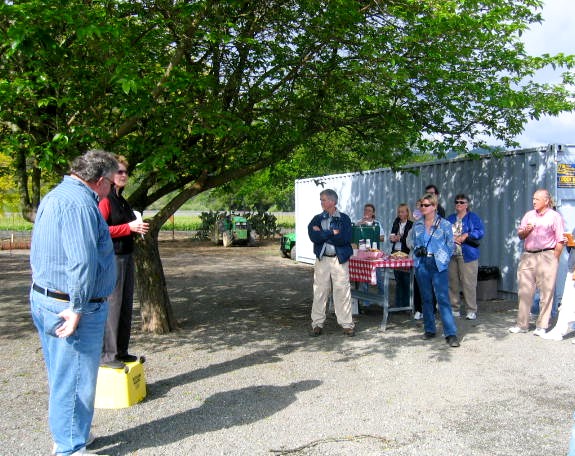
Among the guests was a guy named Jack who had been bringing a group of his friends to Passport for many years. Several of his friends were with him. They all signed up for our newly created mailing list.
Friendships Nourished at a Barbecue
Fast forward to Passport 2006. We still didn’t have a tasting room (the reason is a story for another post), but we had plenty of wine to sell. We decided to have a Passport welcome happy hour at our house on Friday evening and invite the people who had attended the vineyard tour the previous year.
Jack came with several of his friends, and we were all having so much fun, that he called other members of his group who joined in the party. Jack’s gang had a tradition of preparing an upscale barbeque – think Thai grilled beef and noodle salad not grilled hot dogs – at the bed and breakfast where they typically stayed. This year however, they couldn’t stay at their usual place and didn’t have a spot to do their barbecue.
When he heard them talking about it, Mike said, “Hey, if you bring the food, you can host your barbecue here and use our kitchen and our grill.” The next night Jack and his usual cooking buddies, Bruce and Mary, arrived early with coolers full of food ready to cook.
They took over the kitchen, fired up the grill and proceeded to turn out a feast of red curry coconut grilled chicken breasts, grilled asparagus, and French bread. The whole gang of about 20 people arrived and had a fantastic evening of food, wine, and friendship.
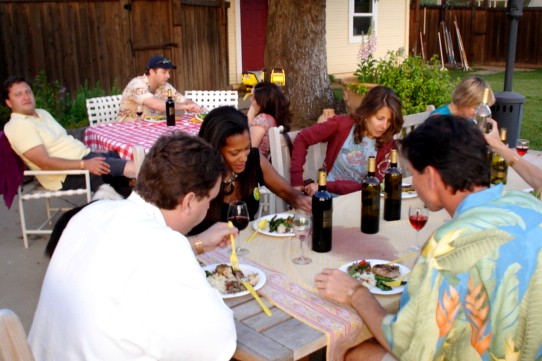
It was fun to hear their stories of how they had all met and how they reunite each year at Passport. One couple even got married at a Dry Creek Valley winery during the Passport event.
Not only did the group do all the cleanup after dinner, but they also purchased many cases of wine, which meant our first-year sales at Passport were a big success!
Passport 2007 rolled around, and our winery was finally under construction but not ready for us to participate in the event. We hosted another happy hour on Friday and invited Jack and his group to return for their Saturday night barbecue.
We couldn’t wait to taste what Jack, Bruce and Mary were cooking up for this year’s feast. I was especially excited that my mother, Lori, and her husband Don were visiting us and could be part of the festivities. They enjoyed getting to know Jack and his friends as much as we had.
Friendships Sustained through the Years
The next year and every year since, Jack and his group have held their Saturday night Passport barbecue at Amista (except in 2020 and 2021 when Passport was cancelled during the pandemic). We moved from our house to the winery in 2008, when our building was finally complete.
Jack fires up the grill to finish his creations. Every year the menu is a little different, inventive, and delicious. Every year we have some new wine to share with our friends. In 2008 it was our first Sparkling Syrah, the wine responsible for Amista becoming the 1st grower sparkling wine house in Healdsburg. No matter what we’re eating or drinking, the company and conversation are always outstanding.
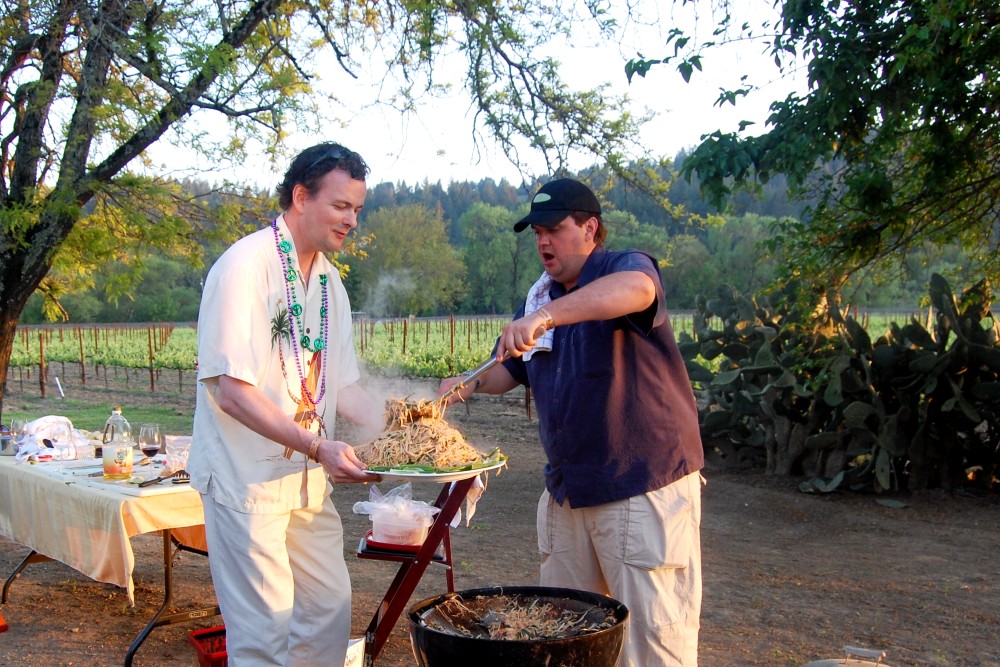
Nearly everyone in Jack’s group is part of our wine club and we’ve had the privilege of following how their lives have evolved – watching their children and now their grandchildren grow. Some of the “kids” joined our club when they became of age along with the mother of one member of the group, so we now have three generations in our Amista family.
Along the way, Jack met and married a wonderful woman, and we now welcome the talented and lovely B to the annual barbecue. She immediately took over the responsibility for the hors d'oeuvres and presented the most gorgeous and delicious cheese board I’ve ever seen!
Jack and B purchased a vacation home just a mile away from us, so now we get to see them more than once a year. They can often be seen with Ashley and the picking crew during our harvest. The crew fell in love with them when they presented them with a box of 2 dozen doughnuts.
Last year when Ashley decided to foot tread some of the grapes for our sparkling wines in the vineyard, B jumped in the bin and went to work alongside Ashley and her kids and members of our tasting room team. B had a blast – she’s the one with her arms in the air and a big smile on her face.
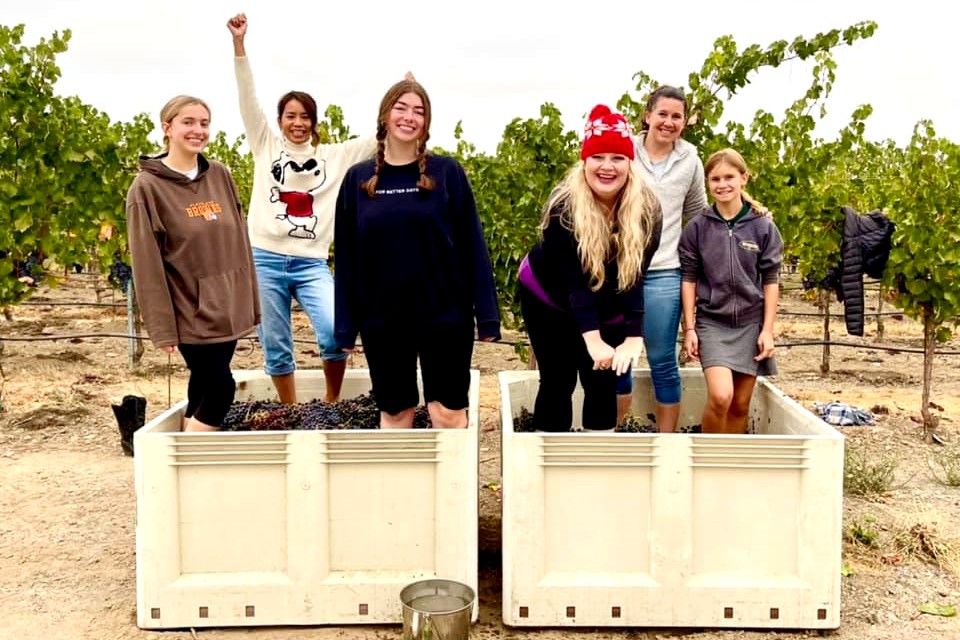
Friendships Enriched during Challenging Times
During the pandemic Passport was cancelled. No one could quite believe that this long-standing event wasn't going to happen for the first time in 30 years. Trips were cancelled; long time guest were disappointed not to enjoy a weekend of food and wine and everyone missed reuniting with their friends. We had to do something.
We asked Jack if he was willing to create a pairing for each of the wines that we had planned to pour at Passport in 2020 and co-host a virtual tasting with us. No surprise, he was excited to do it!
He even prepared each of the dishes for us and left them on our doorstep - since everyone was quarantining at the time - so we would have them for the virtual tasting. Jack introduced each dish; our winemaker Ashley Herzberg described the wines and B made sure each item was artfully plated. They were imaginative creations that paired beautifully with our wines.
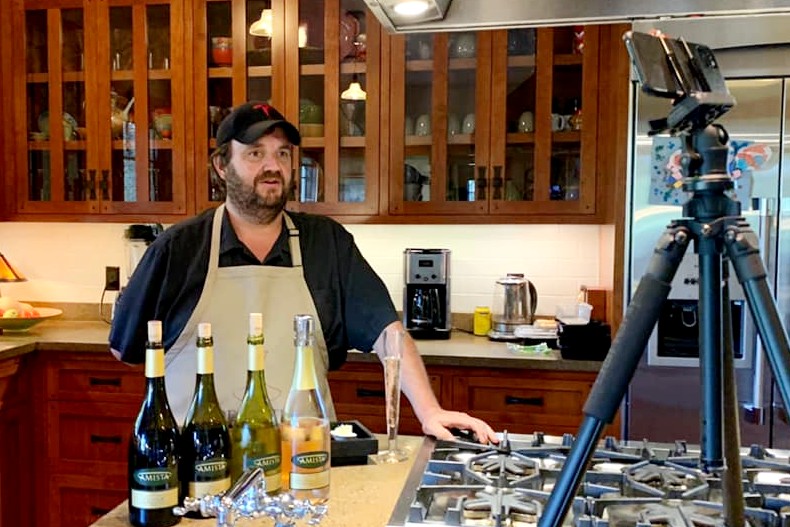
Friendships Celebrated with Gratitude
A few weeks ago, we asked Jack and B to join us for dinner. I was nervous because I volunteered to make the meal, something that Mike typically does. My role is generally relegated to making salads. We decided to serve Cassoulet, a complicated dish with many steps, even though all the meats, including the duck confit, were ready to sauté and layer into the bean mixture I had prepared the day before.
I was especially nervous to be handling the cooking duties since we were serving the results to such an accomplished home chef as Jack. It turned out fine (although next time I will make sure it stays juicy) but more importantly, the chance to gather around the table with Jack and B after nearly two years of not having guests in our home, was priceless.
We reminisced about how we first met and the many Passports we have experienced together. We caught up on each other’s lives. We talked about what we learned during the pandemic. And we gave Jack a special gift thanking him for his 15-plus years of being a supporter, an ambassador, a member, and a friend.
I am proud, and frankly surprised, that Mike and I have been able to build a thriving winery even though we have never owned our own business, never worked in hospitality or agriculture, and never worked together! Far more important, I am grateful for the friendships and treasured memories we’ve experienced on our journey.

If you love delicious food, check out the wine and food pairings with recipes that Jack created for our Passport to Dry Creek virtual tasting.
If you enjoy luxury accommodations and hospitality, check out Jack and B’s beautiful vacation rental, Decanter Healdsburg, just a few minutes from Amista.
If you want to experience the friendly spirit of Amista, Come Taste with Us and enjoy sparkling and Rhône wines surrounded by gorgeous vineyard views in Healdsburg, California in the heart of Sonoma wine country.
Honoring the Women who Fueled the Growth of Amista Vineyards
The Stories of What They Did...
...…and the lessons I learned from them
Let’s raise a glass of bubbles and celebrate women, wisdom and wine! There are many bright female threads woven through the evolution of Amista Vineyards - women who have made a profound difference in our journey. Yes, there are men who have had an important impact as well, but that’s a story for another time.
Sometimes I am amazed that we have gone from making wine in our garage to becoming the first grower sparkling wine house in Healdsburg with a thriving tasting room and a vibrant wine club. I am deeply grateful for all the friends who have supported and guided us along the way.
This is Women’s History Month and today is National Women in Wine Day, a perfect time to say thank you to seven women who have touched our lives, especially mine. Here are the stories of how they shared their wisdom, made a lasting difference and the lessons I learned from each of them.
-
One Small Step for a Woman, One Giant Leap for Amista
Meg, Broomfield, Colorado -
Passion Over Price
Lori, My Mom, formerly Sun City West, Arizona -
You’re Both Right!
Ashley Herzberg, Amista Vineyards Winemaker, Healdsburg, California -
The Yin and Yang of Business
Tammy, Sebastopol, California -
ABC – Anything but Chardonnay
Janice, Belmont & Cheryl, Redwood City, California -
The Art of Creative Combinations
Hallie, Orinda, California -
The Tin Woman, the Scarecrow, and the Lion
Tammy Toth, Amista Vineyards Hospitality Manager, Healdsburg, California

One Small Step for a Woman, One Giant Leap for Amista
When the idea to start Amista was still in its infancy – we had our first wines in the barrel but nothing yet in the bottle – we decided to sign up to host a vineyard tour at Passport to Dry Creek Valley, the premiere wine and food event in Sonoma County.
My friend Meg and her husband Dale flew out from Colorado to attend Passport with us and help us with the vineyard tour. Meg helped me make cookies and quiche to serve for the morning tour but that wasn’t the small step that had such a lasting effect on Amista.
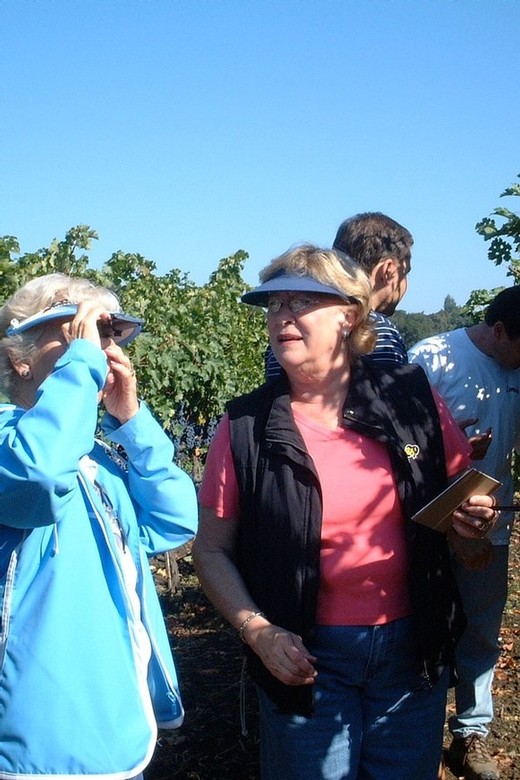
Meg proposed that we have everyone who attended the tour sign up for our mailing list. Mailing list? We didn’t have one. It hadn’t occurred to me.
At the time, my husband Mike was the one with a passion for making wine. I was busy doing executive coaching and consulting and hadn’t given much thought to building a wine business.
Meg’s simple idea led to ongoing friendships with a whole gang of people and their friends who showed up at that first vineyard tour and signed up for our brand new mailing list.
They’ve truly become part of the family – having barbecues at our home and brunches at the winery, joining our wine club, celebrating their marathons, their birthdays, and their family reunions either at Amista or with Amista wines in their glasses. We’ve watched their kids grow up and some of their moms and grown children join our wine club.
In retrospect, it is astonishing and a good reminder that sometimes a seemingly simple act can lead to such a huge impact. You can read the whole story about the gang of friends we met at Passport in another post, “The Best Wines are Those Shared with Friends.”
Passion Over Price
I’ll never forget the day we bottled our “Garage Syrah”. My mom, Lori, and her husband Don drove from their home in Arizona to help. We had a dozen people gather in our garage one overcast, rainy day in December where we made quick work of bottling three barrels of 2002 Syrah, the very first wine Mike made from our new vineyards in Healdsburg, California.
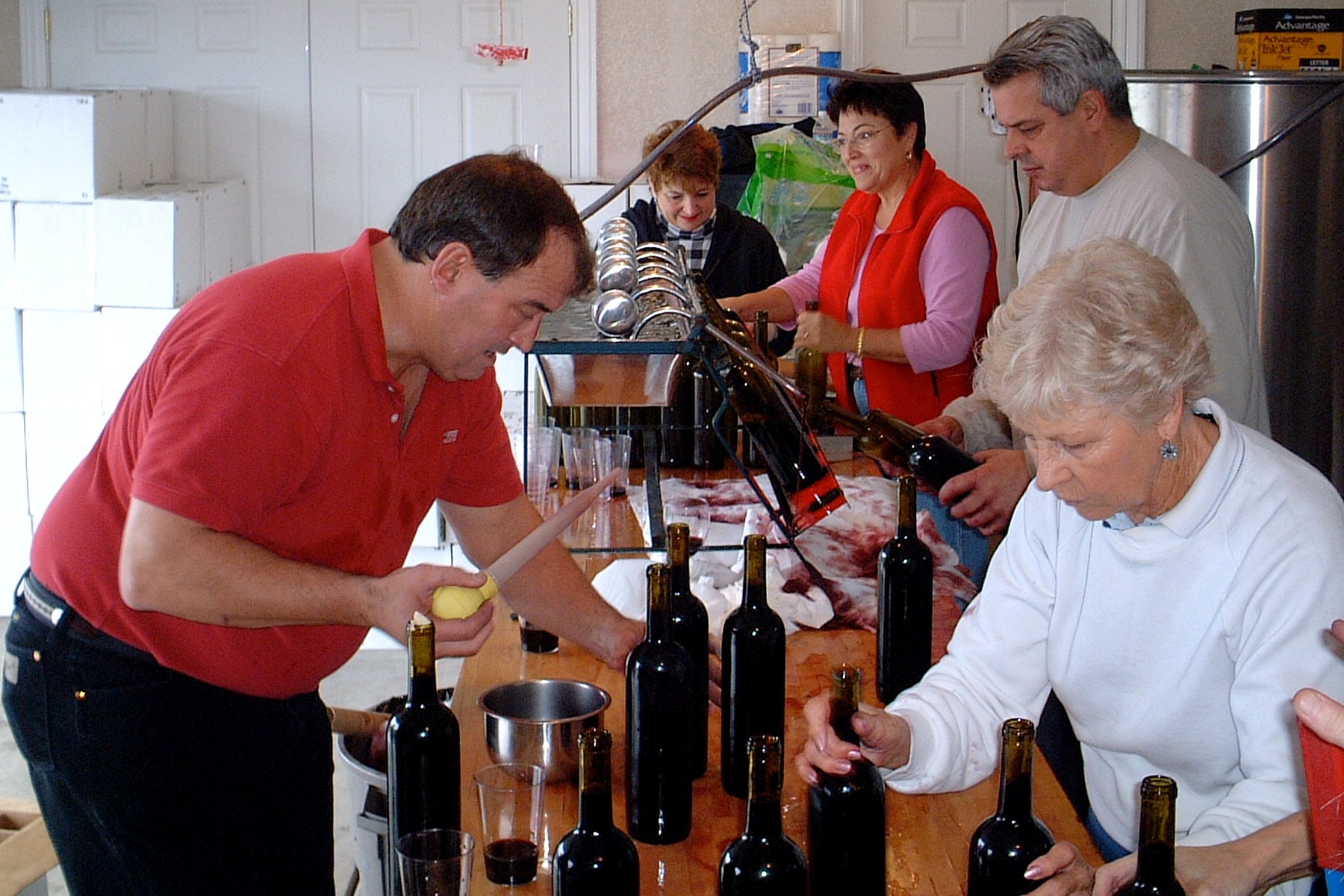
We let everyone take home several cases of wine to thank them for their help. Most couples took two to six cases. My mom sheepishly asked if she could take ten. At that time, she and Don weren’t that much into wine, so I was surprised but secretly pleased. They had so much wine in their trunk that their luggage had to go in the back seat!
About five weeks later I was talking with my mom on the phone, and she was raving about how much they liked the “Garage Syrah” and sharing it with their friends. “The only problem,” she admitted, once again somewhat sheepishly, “is that we ran out.” I couldn’t believe they had already gone through 10 cases. She explained that there were a lot of gatherings in their neighborhood, and our wine was a big hit.
I know, I know, you’re probably thinking the fact that it was free is what made it so popular. There is some truth to that, but what I’ve learned over the years is that much more important than the price of the wine is the genuine enthusiasm of the person who is offering it. For the rest of her life, my mom remained our biggest fan and cheerleader.
You’re Both Right!
Winemaker Ashley Herzberg joined us in 2011, although she had worked with us and our wines for nearly four years as assistant winemaker at a custom crush facility where we make our wines. She had already gotten to know us when she approached us with the idea of becoming our winemaker.
Ashley had decided to strike out on her own as a consulting winemaker, in part for a new challenge and in part because she wanted the flexibility to be a mom. We were thrilled! Secretly we hoped she already had an idea of what it would be like to work with owners who are husband and wife and still learning the wine business.
Her first act was rescuing a problem Zinfandel that we had all but given up on. It started with a stuck fermentation (meaning the wine would not go dry and remained at about 6% residual sugar). We tried suggestions from anyone who knew anything about winemaking, but nothing worked. We then decided to blend it with Syrah, which didn’t fix the problem, it just doubled it!
Ashley proposed making a dessert wine from the sweet red blend – “if you can’t fix it, feature it” – by adding a dose of brandy. We decided to call it Ilusión, the Spanish word for illusion, because it took a bit of Ashley’s magic to transform a mistake into a delightful wine.
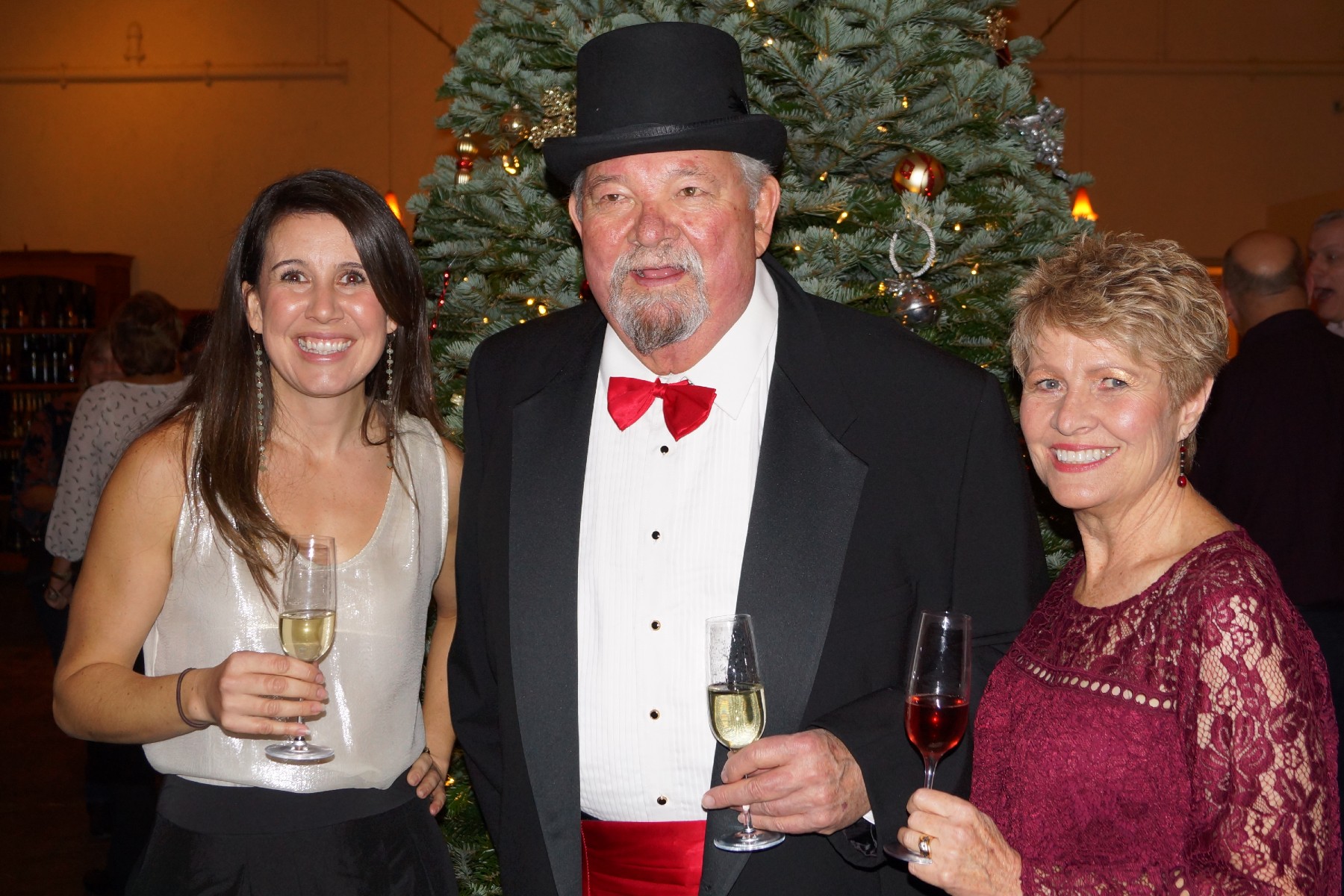
What she might not have known before she joined us is that Mike and I don’t agree on much of anything, at least initially. In fact, the more difficult the situation, the more vociferously we disagree on the path forward. Ashley was often caught in the middle, but her calm demeanor and confidence have been among her greatest gifts to us.
Her typical response after patiently listening to our opposing points of view is, “You’re both right.” Then she proceeds to craft a solution that considers both of our perspectives…or is it just the path she envisioned all along?
There have been so many challenging situations where she has helped us navigate a solution - finding a way to reinvigorate our vineyards that were slowly failing, figuring out what to do after a middle-of-the-night theft of 2 tons of our Mourvedre crop and scrambling to pick as much fruit as we could before the smoke from the 2020 fires affected the grapes.
She is a talented, hard-working, creative winemaker and we are grateful every day for her abilities. I’ve learned a lot about winemaking from Ashley, but not enough to be one, even on TV. What I have learned from her is that patience, creative problem-solving and the attitude of “Yes, and” rather than “Yes, but…” are the secrets to success.
The Yin and Yang of Business
"Goals - we don't need no stinkin' goals." That was us when we first started. We didn’t even have a goal to get into the wine business; it just unfurled.
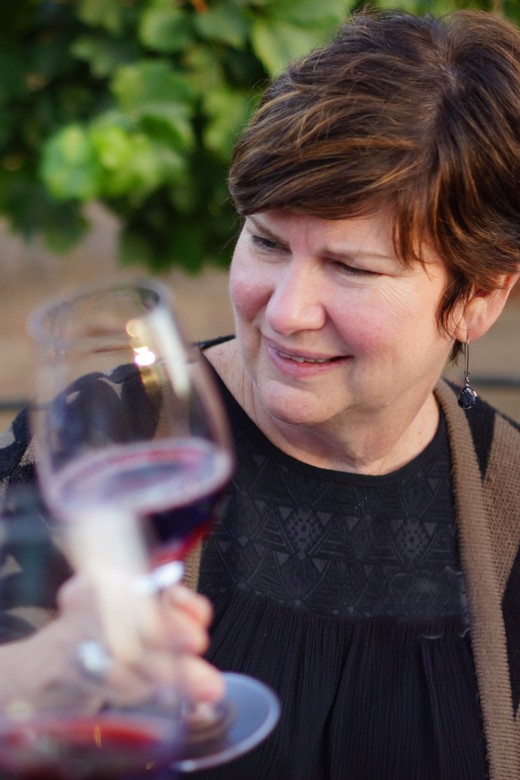 Thankfully, I met Tammy Boatright, the woman who taught me the value of setting goals, measuring results, and monitoring key metrics (Key Performance Indicators) on a daily, monthly, and yearly basis.
Thankfully, I met Tammy Boatright, the woman who taught me the value of setting goals, measuring results, and monitoring key metrics (Key Performance Indicators) on a daily, monthly, and yearly basis.
I knew how to do this in my corporate and later my consulting life, but the wine business felt so different to me, and I was in so far over my head in the early days, it didn’t occur to me to use the tools I already had in my toolkit.
It was my good fortune to meet Tammy as part of a roundtable for women in the wine business. She was my informal sounding board on the business side of wine for several years before she started her own firm helping wineries with a DTC focus (DTC or Direct to Consumer is selling directly to customers rather than selling through distributors). I may have used Key Performance Indicators in my past lives, but I had no idea of how or what to measure in a wine business. Tammy did!
One of the tools her company offered was a simple dashboard with the five key metrics that are most critical to a successful tasting room. The dashboard drew directly from our systems, so there was nothing required on our part except we had to set goals for the dashboard to work.
Setting goals was a game changer for me and my team. Now we had something to shoot for. We could celebrate when we met our goals and figure out what changes to make when we didn’t.
Tammy isn’t all about Yang (strategy, focus, drive, and ambition). She is equally good at the Yin of business (creativity, intuition, compassion, and empathy). She helped me develop creative solutions and innovative ideas for wine clubs, unique offers, staff incentives and even merchandise.
Her intuition is remarkable. She could walk into my tasting room and tell if the energy was positive or if something was off. Typically, she saw it first in the numbers, for example our sales were down, and then she would “feel” it when she walked through the door.
Running a business is lonely and Tammy has been a valuable and trusted advisor. She tells it like it is and when she senses something is wrong, she lets me know. Then she helps me figure out what to do. The lasting and most precious gift Tammy gave me is the consistent practice of setting goals, measuring results and at the same time tuning into the “feel” and the energy of our business.
ABC – Anything but Chardonnay
One day in June of 2004, we invited our club members for a Barrel Tasting party. In the Fall of 2003, we had harvested our first grapes for Amista Vineyards. We brought in Syrah from our estate vineyards and Zinfandel and Cabernet Sauvignon from neighbors in Dry Creek Valley. We were excited to share our new creations with our founding wine club members. We all went to the winery where we were making our wines and tasted the young wines from the barrels.
Then we came back to our house – our winery building was only an application on paper at the time – for a barbecue lunch. As we were sitting around after lunch, two of my friends and club members, Janice and Cheryl, gazed out over our acres of Chardonnay vines and asked, “Why don’t you make Chardonnay?”
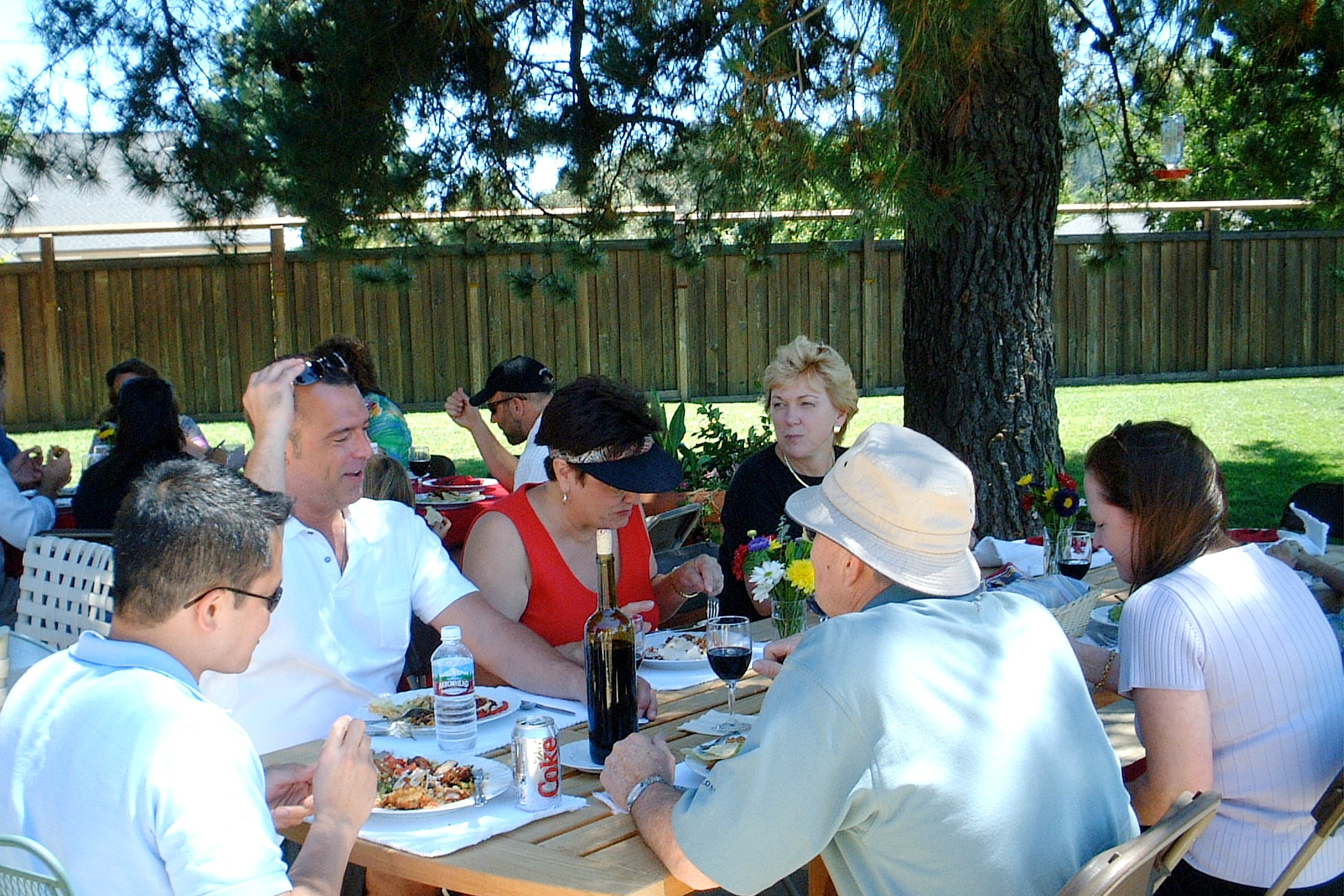
I answered, “Because we don’t like Chardonnay!” Their retort, “But we do!” So I asked them, “If we make it, will you drink it?” and they answered with a resounding yes. I was just barely starting to get the hang of the wine business at this point, but at least had the sense to ask, “Will you buy it?” Once again, I was met with a resounding yes. The next year we harvested Chardonnay from the blocks right outside our bedroom windows and have been making it ever since.
To be honest, the reason we didn’t care for Chardonnay is because we had only tried the heavily oaked, buttery Chardonnays that were popular in California at the time. We agreed to make it if we could find a style we liked. That led to several months of trying various Chardonnays and discovering that we didn’t have to ferment in new oak barrels. We could ferment in stainless steel or neutral oak barrels – those that had been used for several years – thus imparting no oak flavor to the wine.
We decided to make a more Burgundian style Chardonnay and ferment in neutral oak barrels. Mike had great fun using four distinctive yeasts, each offering a slightly different flavor component to the wine and then blending them all together. The result was a bright Chardonnay that let the fruit – rather than the oak – shine through and offered layers of complexity from the different yeasts.
I am quite certain that without the prompting from Janice and Cheryl, we would have never made a Chardonnay. My lesson learned was to listen to our customers and at the same time, be true to ourselves.
The Art of Creative Combinations
We had just released our first wine in the late summer of 2005, when I was invited to pour at a reception in Oakland at a conference for women in business. I had only one wine to pour, our 2004 Chardonnay since our red wines were still in barrel.
I had never poured wine at an event in my life, but I was the logical choice because it was a women’s event. The Chardonnay was a big hit, and I collected a whole bunch of business cards from the women who tasted.
Best of all, I met a women named Hallie, who has touched Amista in countless ways since that fortuitous reception. Her first act was born of her passion for good food and her gift of making splendid combinations. As we talked and she tasted, she wrote out a recipe for “Hallie's Roasted Garlic & Onion Jam Crostini.” She thought it would pair well with our Chardonnay. It does!
Her next act was introducing us to her friends and colleagues who came to our Amista launch parties, joined our founders wine club, came to our events, and bought our wines. She is always full of creative ideas and connections. She even found a fabulous private chef, Cindy, who catered some of our first tasting parties and founders’ event.
Later Hallie and the Cindy cooked up a fashion and wine pairing show with Susan, another of her friends who did trunk shows. Susan chose five outfits each for a different occasion like a Girlfriends Holiday Luncheon. Cindy created a menu for each occasion, and I paired each menu with an Amista wine. As the models showed off each outfit, we described the occasion and the menu while the guests sipped on the wine.
One of my favorites was a casual outfit for a Game Day Tailgate Party. Here is the menu, which I last looked at in 2006. It still sounds delicious!
And speaking of delicious, Hallie and my husband Mike once did a wine club event we called Battle Pizza. Hallie taught everyone how she makes pizza dough and then created an artisanal pizza. Mike made a more traditional pie and they baked up both in our wood fired oven. Then everyone got to enjoy the results. It was great fun.
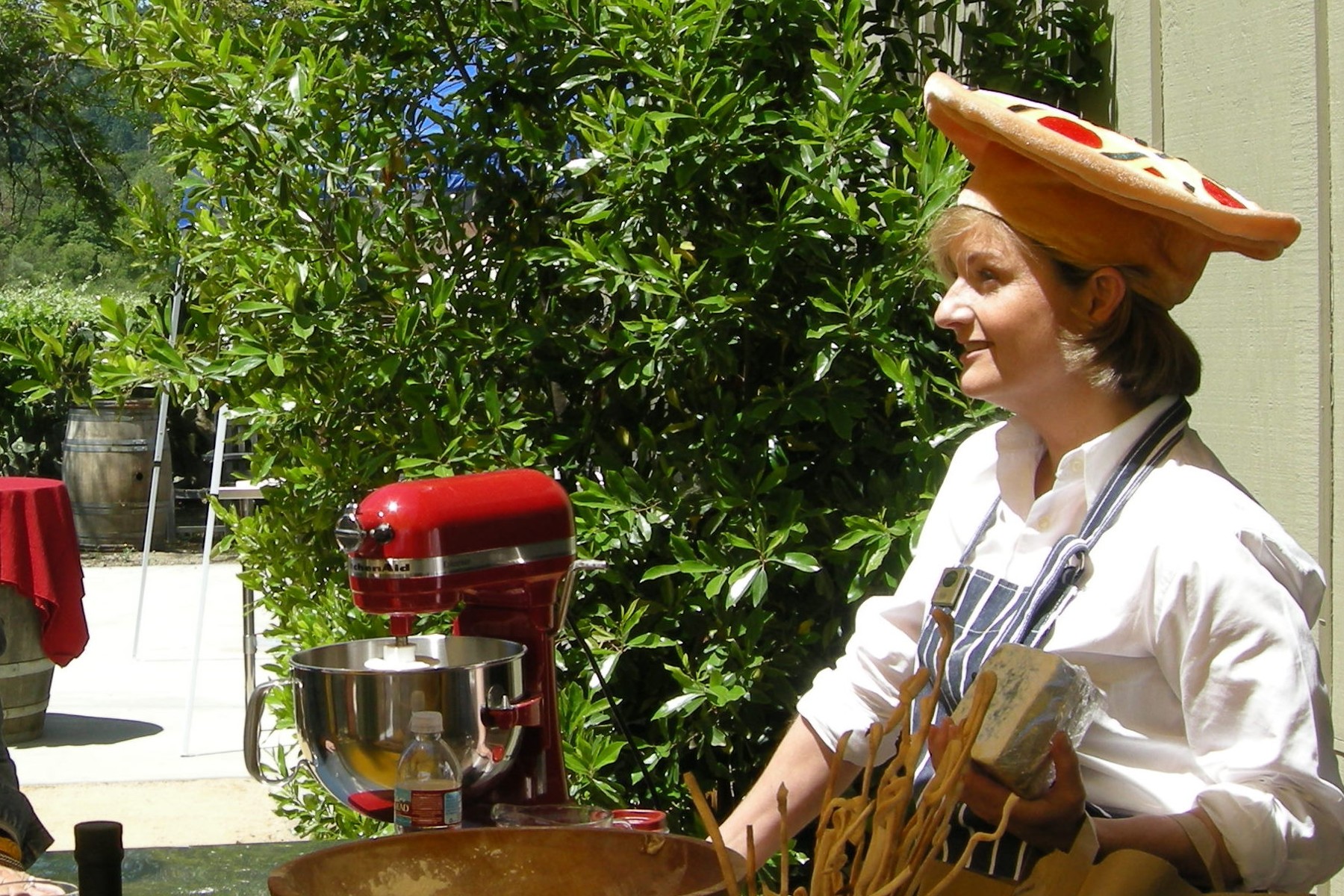
What I’ve learned from Hallie is the art of creative connections. Her imagination shines through in bringing together combinations that wouldn’t occur to everyone – foods, wine, projects, and people.
The Tin Woman, the Scarecrow, and the Lion
Amista, roughly translated, means making friends in Spanish. That is how our Hospitality Manager, Tammy Toth came to Amista, through one of her daughter’s friends who saw our ad and said, “This is the perfect job for your mom.”
Tammy embodies everything that Amista stands for – friendly, bubbly, engaging, and approachable. She joined us in April 2017 and has turned out to be the heart and soul of Amista. She is genuinely curious and interested in everyone who comes through the door – guests, club members, team members and partners, (even owners!) – and makes everyone feel welcome. She also has a great sense of humor. Tammy is on the right in the photo below, beneath our 200-year-old oak.
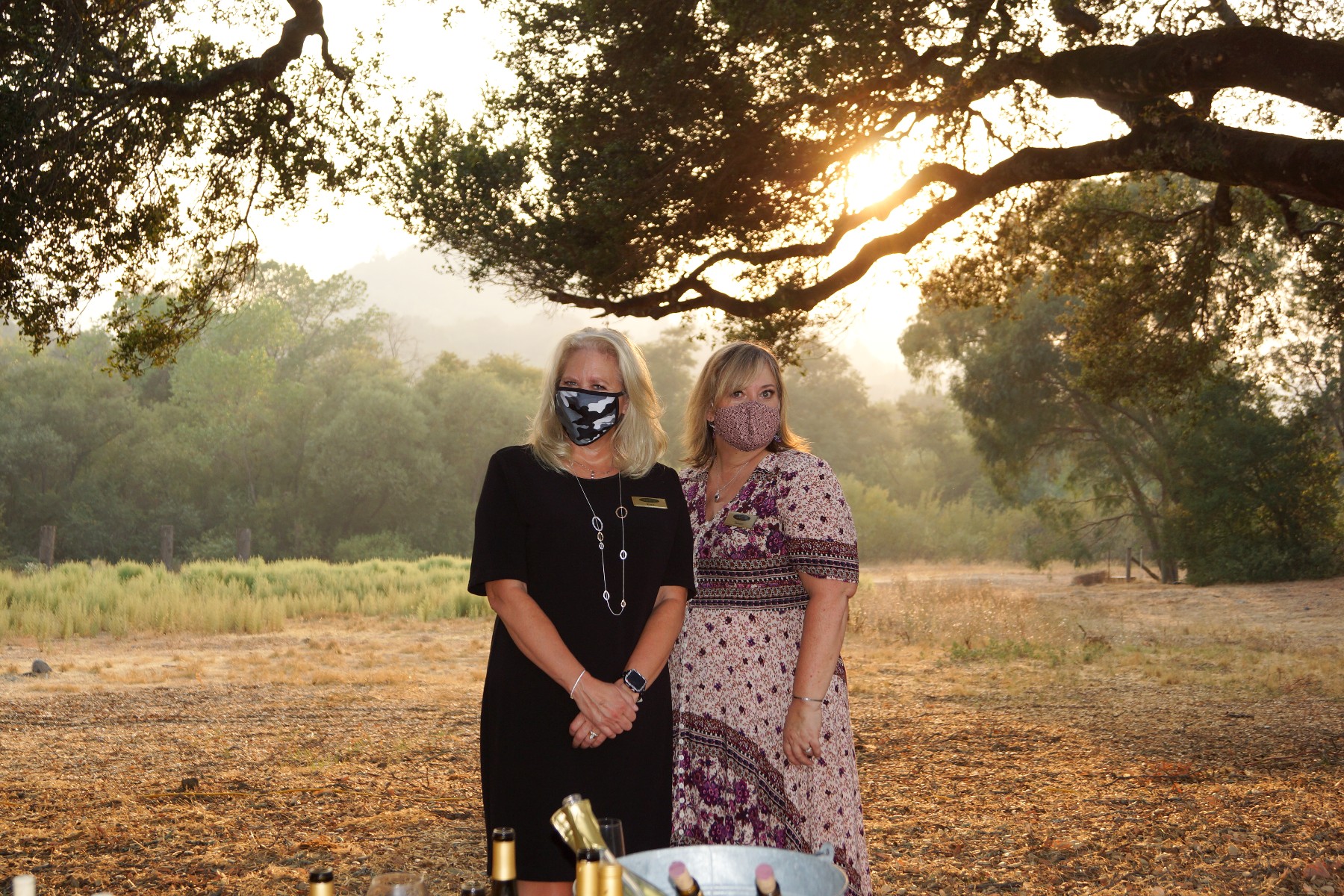
She has an astute business focus and drive to succeed. She is always first to check the numbers and see how we are doing against our goals and the benchmarks. She is constantly looking for ways to improve results, helping her team achieve their goals and celebrating their successes.
She puts their success ahead of her own and cares deeply about each person, encouraging them to constantly push themselves, not only to be more successful but to be more fulfilled (even when that means watching them leave Amista for their next adventure).
It's rare to find the combination of a great hospitality person who also has a fierce focus on business success. It’s even more rare to find a leader who also has the courage to stand up for what’s right – for the business and her people. Tammy is someone I can count on to have the most difficult conversations with me about things I honestly wish I didn’t have to hear but need to know.
Tammy embodies the combination of what each of the characters in the Wizard of Oz was searching for. She has heart, she has brains, and she has courage. This combination is what results in her attitude of finding the good, the positive and the hope in every situation.
I’d like to say that I’ve learned these lessons from Tammy. The truth is that remaining positive and confident in the face of adversity is sometimes a struggle. What I know is that I have a lot of wonderful women around me who will help if I have the courage to ask for their advice and support.
Thank you to these seven wonderful women and all the others in my life who’ve had an impact on me and Amista Vineyards.
And cheers to all the women in wine on this second annual Women in Wine Day - click the link and scroll down to see Ashley and me stomping grapes!
5 Secrets of a Sparkling Winemaker
How Ashley Herzberg led Amista Vineyards to Make Sparkling Tres
...…a sparkling blend of Grenache, Syrah and Mourvèdre.

This is a story about Ashley Herzberg, our amazing winemaker and how she persuaded us to make our newest sparkling wine. We debuted Sparkling Tres, the sixth wine in our collection of sparkling gems, last month, February 2022, so it’s a fitting time to reflect on the journey.
Ashley is a fantastic winemaker, but this story isn’t about her talent as a winemaker. It’s about her leadership and influence skills. They make her an even better winemaker and a joy to have on our team.
The story of how we came to make Sparkling Tres is a good way to illustrate her leadership abilities. As a former executive coach and student of leadership, I have a deep fascination and appreciation for what makes a great leader. I love to watch leaders in action and distill the things they do that make them successful. Here are my picks for the top five things Ashley did to help us become the 1st sparkling wine house in Healdsburg and add the sixth wine to our collection of bubbles.
Take a good thing and make it better
When Ashley joined us as winemaker in 2011, she enthusiastically embraced the wines we had been making since we started Amista in 2004. We made Syrah and Chardonnay from our own estate grapes and Cabernet and Zinfandel from the vineyards of our Dry Creek neighbors. We also made two rosés from our Syrah – one still and one sparkling.
She didn’t come blazing in with plans to plant new varieties, introduce new wines or buy more fruit. With her quiet confidence and winemaking talent, she took what we had and made everything better each year.
There was just one new project the first year Ashley joined us that she and I cooked up together. A few months after she arrived, I asked her if she thought we could make a Blanc de Blanc from our chardonnay grapes. She had yet to make a sparkling wine, but she too loves bubbles and said, “Absolutely”.
During her first harvest at Amista, she picked some of our Chardonnay early to make Blanc de Blanc. The inaugural release of our Amista Blanc de Blanc in 2013 scored 91 points and won a gold medal in the Press Democrat’s “Best of the Best” North Coast Wine Challenge.
Plant the seeds for change
Every wine we made during our early years was from a single variety (except Ilusión, a port-style dessert wine, but that’s a story for another time). Although making single varietal wines requires skill and has its own set of challenges due to the vagaries of weather and water with each vintage, winemakers love to do blends.
I’m not a winemaker, but my impression is that making a wonderful wine from a single varietal is like grilling a perfect steak. You start with a great piece of meat, season it with just the right amount of salt and pepper, get the grill blazing hot, put the steak on, turn it after it browns on one side and take it off immediately when it reaches the right temperature. Don’t get me wrong, it isn’t as easy as it sounds without practice. It takes skill and experience to do it perfectly.
But making a blended wine must be more like a chef creating and preparing a complex dish that brings together several ingredients, requires many steps and techniques and results in a tapestry of flavors and textures. Think of cassoulet with confit of duck or a chocolate souffle with crème anglaise. It’s more challenging than grilling a steak and tests the creativity, the palate, and the experience of the chef.
So, I totally understand why Ashley would want to make a blend. She loves to learn, and she greets every challenge as a chance to learn something new. But my husband Mike and I had never made a blend and it seemed daunting to us. So, she planted a seed.
We had budded over some of our Syrah vines in 2011 creating about an acre each of Grenache and Mourvèdre, thinking it would be fun to make a couple more Rhône style varieties. Apparently, she had another idea.
One day she said casually, “We’ll have some new Grenache and Mourvèdre fruit coming on next year. What do you think about making a GSM (Grenache, Syrah, Mourvèdre) blend from our three Rhône varieties?” We gave our usual answer, something like “Hmmm. We were planning to make a standalone Grenache and Mourvedre. We’ll have to think about it.”
She gently raised the idea on several more occasions, sharing her excitement and confidence that she could make a beautiful blend. She had us try a few GSM blends so we could see if we liked them.
It didn’t take long before we agreed. During the 2012 harvest, which was only her second at Amista, she picked those three varieties to make Tres (three in Spanish). We released it in 2014 and it quickly became Mike’s new favorite wine.
Share genuine excitement
Part of the reason we agreed is because Ashley was so excited about the prospect of making our first blend. One of the things I most admire about Ashley is that she loves what she does, and she shows it. She bubbles with enthusiasm as she talks about her work. And she loves to share what she has learned.
One of the favorite parts of our annual winemaker dinner in the vineyards is Ashley’s vineyard walk. Our guests ask her endless questions, and she not only has thoughtful, easy to understand answers about the most technical aspects of grape growing and winemaking, but her joy in sharing it is palpable. People who truly enjoy their life’s work are inspiring and the excitement is contagious.
Seize opportunities
The next step in the journey was to make a rosé from the same three grapes. Ashley wanted to try doing a saignée when she crushed each of the varieties for Tres. A saignée involves draining off a portion of the juice from a tank of crushed red grapes. This technique increases the ratio of skins relative to juice in the tank and typically results in a more concentrated red wine that is richer, deeper in color and has more tannins.
Often the juice that is bled off is flushed down the drain. Ashley thought it would make a delicious rosé. It sounded like a great deal to me – harvest grapes for a red wine and get a rosé as a bonus. We debuted our first Rosé de Tres in 2018, and it turned out to be a beautiful wine, from the bright rose color to the crisp acidity.
Keep building on your success
Ashley seized many opportunities to add new winemaking techniques and new wines to our portfolio over the next several years. A huge focus has been on making a collection of sparkling wines. She continues to make Sparkling Syrah, the only sparkling wine we were making when she joined us, and the Blanc de Blanc from our Chardonnay that she made in her first year.
She was especially keen to make a Sparkling Grenache, a delicate sparkler that has become a crowd favorite and earned Amista the honor of being selected as one of 10 Hot Brands from across the US in 2017.
As you might guess, she wanted to make a sparkling blend and crafted a wine we call Fusión, made from Chardonnay with a kiss of Grenache and a bit of either Syrah or Mourvèdre.
Her next experiment was to make a sparkling wine from our Mourvèdre, which we call by the Catalan name, Mataró. It turned out to be a brilliant addition to our line-up for its glittering cherry color in the glass and flavors of juicy summer strawberries. From the description, it might sound like a sweet wine, but all our sparkling wines are quite dry, typically Brut, Extra Brut or Brut Nature.
Ashley continues to build on her successes and find ways to experiment with blends. So, the creation of a Sparkling Tres was probably inevitable. The only reason it didn’t happen sooner is because we didn’t have enough Grenache for all the wines we wanted to make. Once our new Grenache block was producing fruit, her dream of making a Sparkling Tres became a reality and we have Ashley’s artistry as a winemaker and her talent as a leader to thank for it.
Read more about Winemaker Ashley Herzberg.
The Best Sparkling Wine - 5 Tips
Secrets from my Journey into Sparkling Wine
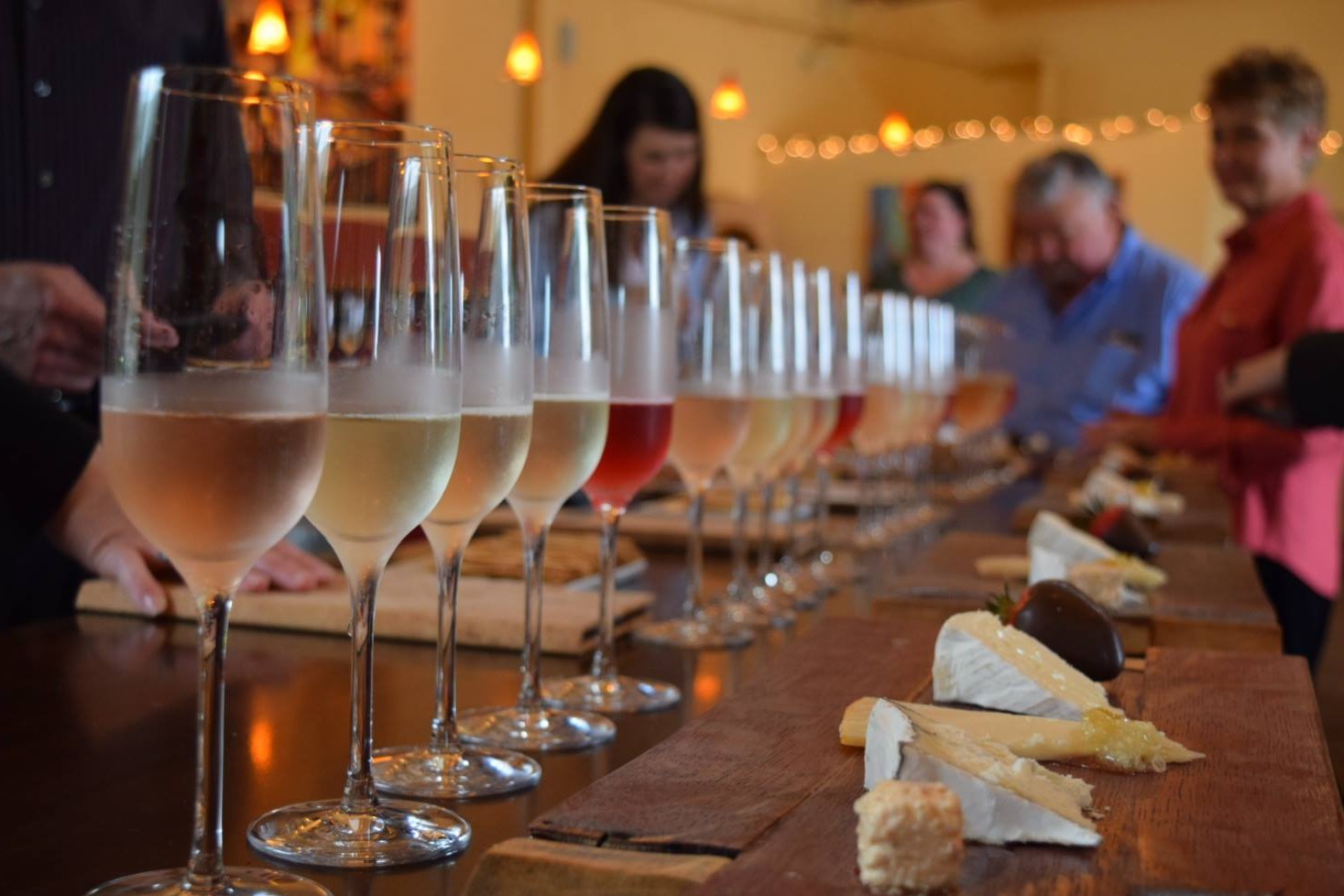
...and it isn't complicated!

At Amista Vineyards, we are on a journey to make the best sparkling wine. It wasn’t a plan. It simply evolved. Now it’s an adventure and a passion that excites me every day.
I want to let you in on the secrets I’ve learned along the way about finding the best sparkling wine. They aren’t rocket science. They aren’t complex. It turns out I knew the answer all along. I was just over-complicating things. Here are my five simple tips for enjoying the best sparkling wine.
Who says what is the best sparkling wine?
Tip #1. You!
My biggest revelation about being in the wine business is that no one is a better judge of what is the best than I am – or than you are. I used to think there was a right and wrong answer. Now I realize that everyone has a different palate, including every critic, writer, wine expert and every one of your friends. In fact, some of them don’t even like sparkling wine. That’s OK.
Did you ever wonder why someone raves about a wine and you find it blah? Or why you can’t wait to share a wine with a friend, and they don’t fall in love with it? Everyone’s taste is unique. You don’t have to like what everyone else likes. You just have to find the wines you enjoy.
And don’t be surprised if your tastes change. That’s the other thing that has been so much fun about my adventure into wine and sparkling wine in particular. Sometimes it's the food that makes a wine taste best. Sometimes your tastes change over the years.
Sometimes it is the setting. I can remember a warm afternoon after driving across Tuscany with our best friends and finally ending up on the terrace of a lovely bed and breakfast with a view of the towers of San Gimignano. We were tired from the drive. Our hosts brought out glasses of wine and plates of cheese and charcuterie. It was a special moment and that was the best wine in the world!
How do I find the best sparkling wine?
Tip #2. Explore
There are so many countries that make sparkling wine – the classic Champagne from France, Spanish Cava, South African Cap Classique, Sekt from Germany and Austria, American sparkling wines and more. Take a virtual trip around the world and try a few from each country.
There are also many varieties of grapes that are made into sparkling wines. The traditional grapes of Champagne are Chardonnay and Pinot Noir. Today, sparkling wines are made from a wide array of grape varieties.
At Amista we are on a mission to make the best sparkling wine from our estate grown Rhône varieties like Grenache, Syrah and Mourvèdre, although we give a nod to tradition and make a Blanc de Blanc from the Chardonnay that we grow in our estate vineyards.
You can also find sparkling wines made from Zinfandel, Pinot Gris, Riesling, Gewürztraminer, Muscat, Cabernet, Cabernet Franc, Sauvignon Blanc, Tempranillo, Pinotage, Malbec, and various Italian varietals like Vecchio. And the list goes on.
If you truly want to find your best sparkling wine, put each of these varieties on your bucket list and try a few bottles from different producers each month. OK, so it might take a few years, but what a great adventure!
In fact, how about getting a group of friends who want to explore with you and having a different person chose a variety (or a country) and host a tasting each month – a sparkling wine of the month club!
If that isn’t enough, you can explore the styles of sparkling wines from dry (brut nature) to sweet (doux) or the length of time the sparkling wines are aged in the bottle. There is so much to discover!
What glass do I use for the best sparkling wine?
Tip #3. It depends
Here again, I used to think there was a right answer. What I discovered is that the right answer seems to change over time partly because Champagne and sparkling wine have changed – becoming more effervescent, dryer and more aromatic. Tastes have also changed. In the 17th century, the coupe was the ideal glass.
Later the flute, became the proper glass. Scenes of tall, elegant glasses being raised in a toast come to mind and evoke celebration. Flutes are usually notched inside the base causing that beautiful stream of bubbles to rise in the glass. I must admit, I love flutes, the taller the better, and I love watching that stream of bubbles ascend and create a little ring on the top of the liquid.
Lately, I have come to appreciate a glass more closely resembling a white wine glass, with one condition – it must be notched. I want to see, and I want everyone around me to see that it is sparkling wine in my glass! If you can’t tell it’s sparkling wine by the shape of the glass, then you must have the telltale stream of tiny, elegant bubbles floating up through the wine.
You can choose to go with what is currently in vogue, pick the one you like best and stick with it, or have a set of each kind of glasses to match your mood and the occasion. It all depends on you.
What foods do I serve with the best sparkling wine?
Tip #4. Experiment
I have always loved bubbles since long before we started making them, but I never thought much about how they went with food. I now pay a lot more attention and I’ve learned two things.
First, try a lot of wines with a lot of foods to discover the best sparkling wine pairings. There are some traditional favorites like Blanc de Blanc with oysters or blinis and caviar. Be sure to treat yourself to these classic pairings.
The second thing I’ve learned is not to be afraid to try sparkling wines with simple, everyday foods. The best sparkling wines don’t have to be saved for fancy, elegant dishes. At Amista we pair our Blanc de Blanc with freshly popped popcorn with a drizzle of olive oil and lemon herb salt.
At home, we regularly have sparkling wine with pasta dishes, stir fry, curries, sushi, taco salad, roast chicken, grilled fish – you name it, we try it. Most of the time it works; sometimes it doesn’t!
How do I truly enjoy the best sparkling wine?
Tip #5. With friends.
Amista means making friends, so the answer to this question is very simple for me. The best sparkling wine is the one you enjoy with good friends.
We invite you to Taste With Us on your journey to discover your best sparkling wines.
